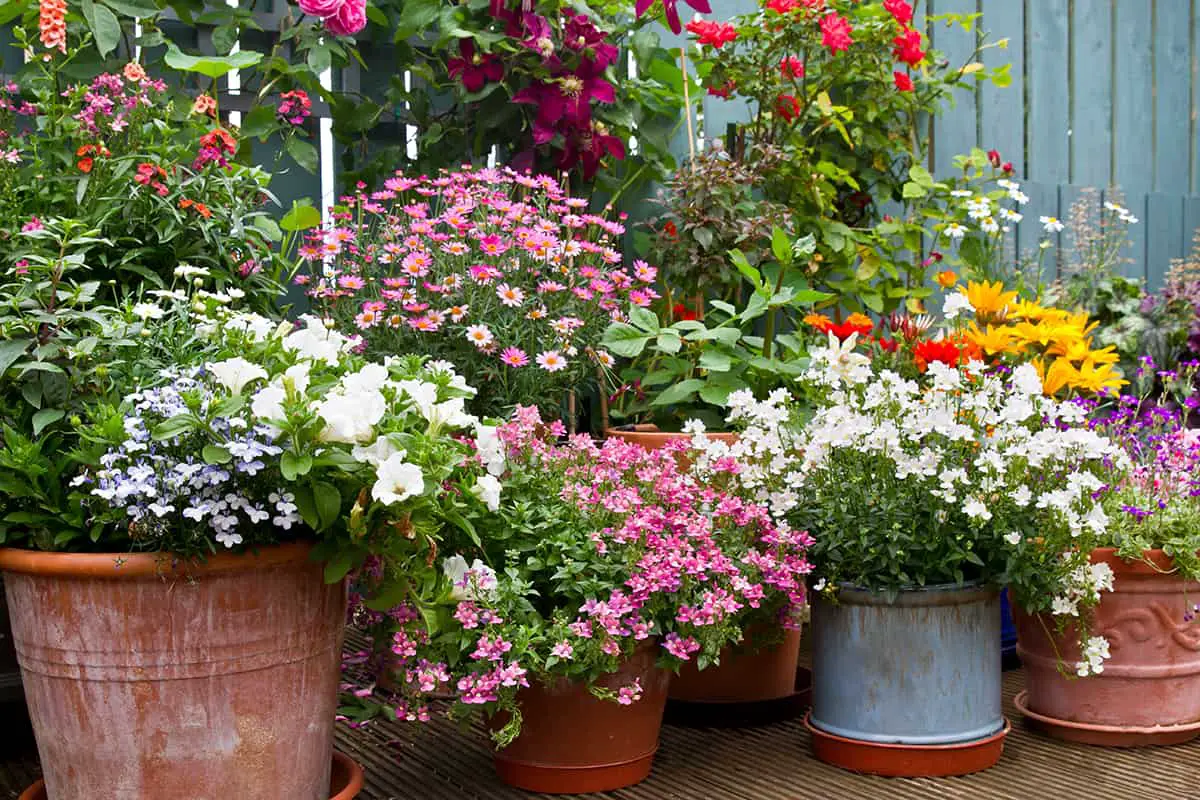Your small balcony or patio has the potential to turn into a lush, leafy retreat. Take the Agave plant, for instance. Its bold, sculptural leaves instantly add a touch of modern elegance to any space, proving that you don’t need a sprawling garden to enjoy the beauty of architectural plants.
These plants, celebrated for their unique shapes and textures, thrive in containers, making them perfect for enhancing urban outdoor areas or indoor spaces.
Let’s dive into how to bring structure and interest to your own slice of the outdoors with the best architectural plants suited for container gardening.
Table of Contents
- Agave
- Aloe Vera
- Bamboo
- Banana Plant
- Bird Of Paradise
- Boxwood
- Canna Lily
- Cast Iron Plant
- Colocasia
- Cordyline
- Dracaena
- Dwarf Citrus Trees
- Dwarf Olive Trees
- Dwarf Pomegranate Tree
- Elephant’s Ear
- Euphorbia
- Fatsia Japonica
- Fiddle Leaf Fig
- Giant Rhubarb
- Hens-And-Chicks
- Hostas
- Jade Plant
- Japanese Maple
- Ornamental Grasses
- Palm Trees
- Phormium
- Rubber Plant
- Sago Palm
- Succulents
- Swiss Cheese Plant
- Yucca
- Zebra Plant
Agave
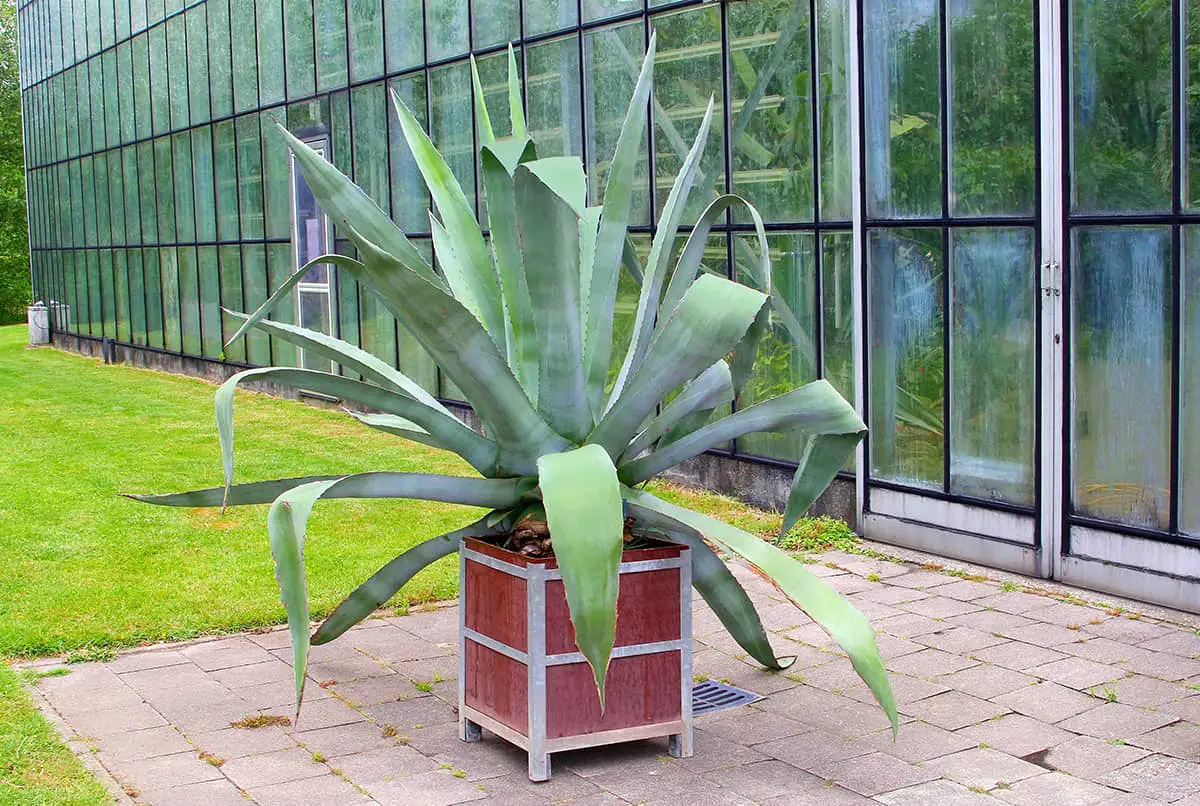
Agave plants create a bold visual statement in your container garden, with their rosette shapes providing an eye-catching allure. While certain varieties are well-suited to cooler climates, others flourish in warmer conditions.
Regarding size and growth, Agave americana, also known as the century plant, is notable for its large size. It can reach heights between 5 to 7 feet and spread out 8 to 12 feet wide. For smaller spaces, smaller species like Agave parryi are more appropriate due to their compact size.
When it comes to care, agaves require soil that drains well. They have a preference for sunny locations, although some varieties can tolerate partial shade. These plants are drought-tolerant and only need occasional watering during the summer months.
For design tips, choosing a shallow clay or terra cotta pot is advisable. Mixing different species can create an appealing contrast in shapes, and adding gravel on top can achieve a clean and finished look.
It’s important to note certain features of agaves; they possess long, pointed leaves that may have sharp edges and spines, posing a risk if not handled carefully. Additionally, agaves flower rarely, often only after many years, making their bloom a rare and significant event.
Aloe Vera

Aloe vera stands out as an exceptional choice for container gardening thanks to its succulent nature, which flourishes in well-drained soil with minimal watering requirements. It adapts well to indoor environments or temperate outdoor settings. The plant is distinguished by its thick, spiky leaves, which are filled with a gel acclaimed for its ability to soothe burns.
To successfully cultivate Aloe vera in a container, you should adhere to the following steps: select a pot equipped with drainage holes, fill it with a cactus potting mix, and ensure the plant is watered sparingly.
This plant has a preference for bright, indirect sunlight and should be shielded from intense, direct sunlight to avoid leaf scorch. Aloe vera plants can achieve a growth range of 12 to 36 inches in both height and spread, making them a versatile addition to any space.
Bamboo

Bamboo plants make a bold statement in your container garden. They are versatile, growing both indoors and outdoors. You’ll find bamboo useful for privacy screens or as a natural, tall backdrop for other plants.
Growing bamboo in containers offers several advantages, such as easy control over its spread, which is a common concern with in-ground planting. Containers naturally limit the bamboo’s ability to spread uncontrollably. Additionally, the portability of containers allows for the adjustment of the plant’s exposure to light, offering flexibility in positioning to optimize growth and health.
However, there are also drawbacks to consider when growing bamboo in containers. It requires regular maintenance, including consistent watering and fertilizing, to ensure the plant remains healthy and vibrant. Furthermore, the necessity for large, sturdy containers can be a consideration, as bamboo needs ample space to accommodate its root system.
For those looking to achieve success in growing bamboo in containers, selecting the right container is crucial. It should be both deep and wide to accommodate the bamboo’s roots, known as rhizomes, which need space to grow. The soil within the container should be well-draining to satisfy bamboo’s preference, and consistent moisture is important without causing waterlogging. Most bamboo species thrive in sunlight, but partial shade is often recommended to prevent leaf burn. Additionally, installing rhizome barriers at the bottom of the container can prevent the rhizomes from escaping through the drainage holes, ensuring the bamboo remains contained and manageable.
Banana Plant
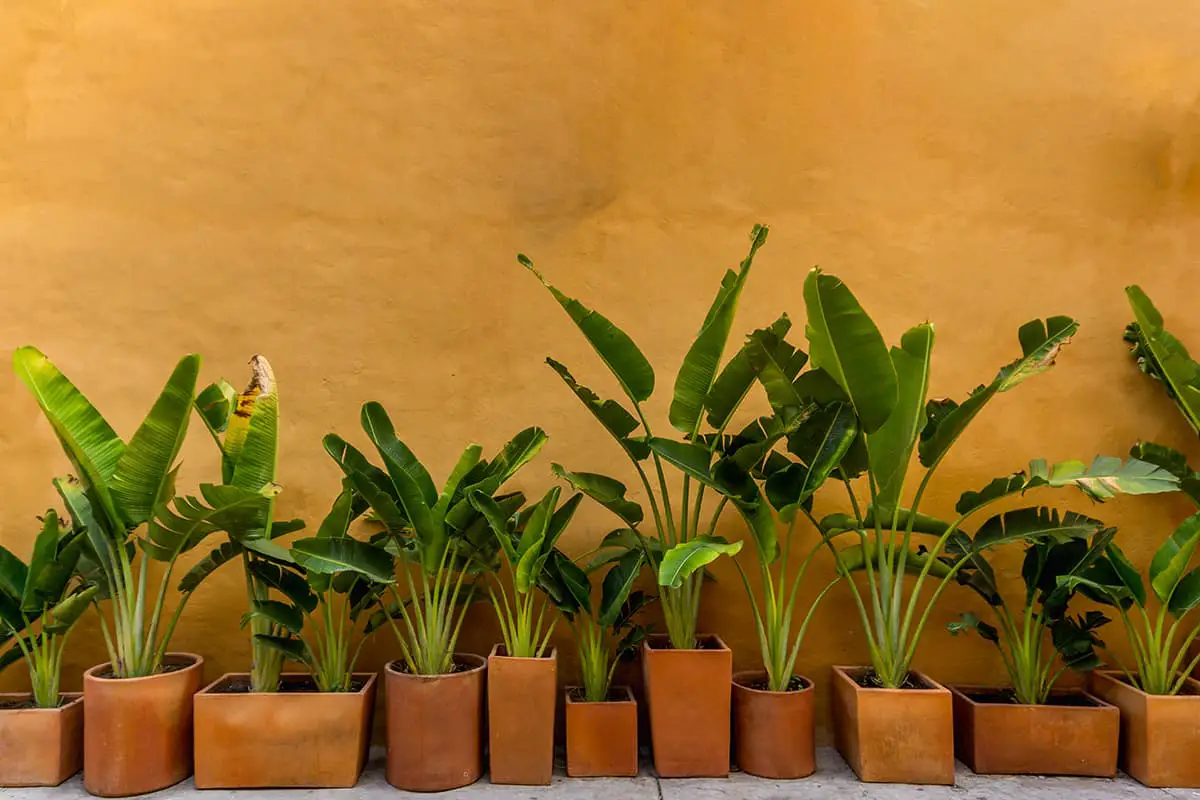
Banana plants can transform your container garden with their tropical flair. They need a deep and wide container, ideally 18-24 inches in both dimensions. This space supports root expansion, crucial for healthy growth. Full sun is another requirement for your banana plant. Ensure it gets sun for most of the day but is also shielded from harsh wind.
Ornamental bananas, like Musella lasiocarpa or Ensete ventricosum, are more suitable for containers due to their size. To cater to their love for humidity, mist the leaves regularly. Water the banana plant liberally, as they thrive in moist soil conditions. However, ensure good drainage to prevent waterlogging.
In colder climates, protect your banana plant with heavy mulch or move it indoors during winter. Expect top growth to die back, with the roots surviving for regrowth in spring. For example, the Basjoo variety is hardy in zones 5 through 11 and can cope with cooler temperatures when mulched correctly.
Banana plants are not just for their lush foliage; they also produce stunning flowers. The inflorescence emerges after about 10 to 15 months. It consists of attractive flowers that are arranged in groups, often leading to the production of fruit.
Keep in mind, banana plants in containers will likely remain smaller and may produce less fruit than those planted in the ground.
Bird Of Paradise
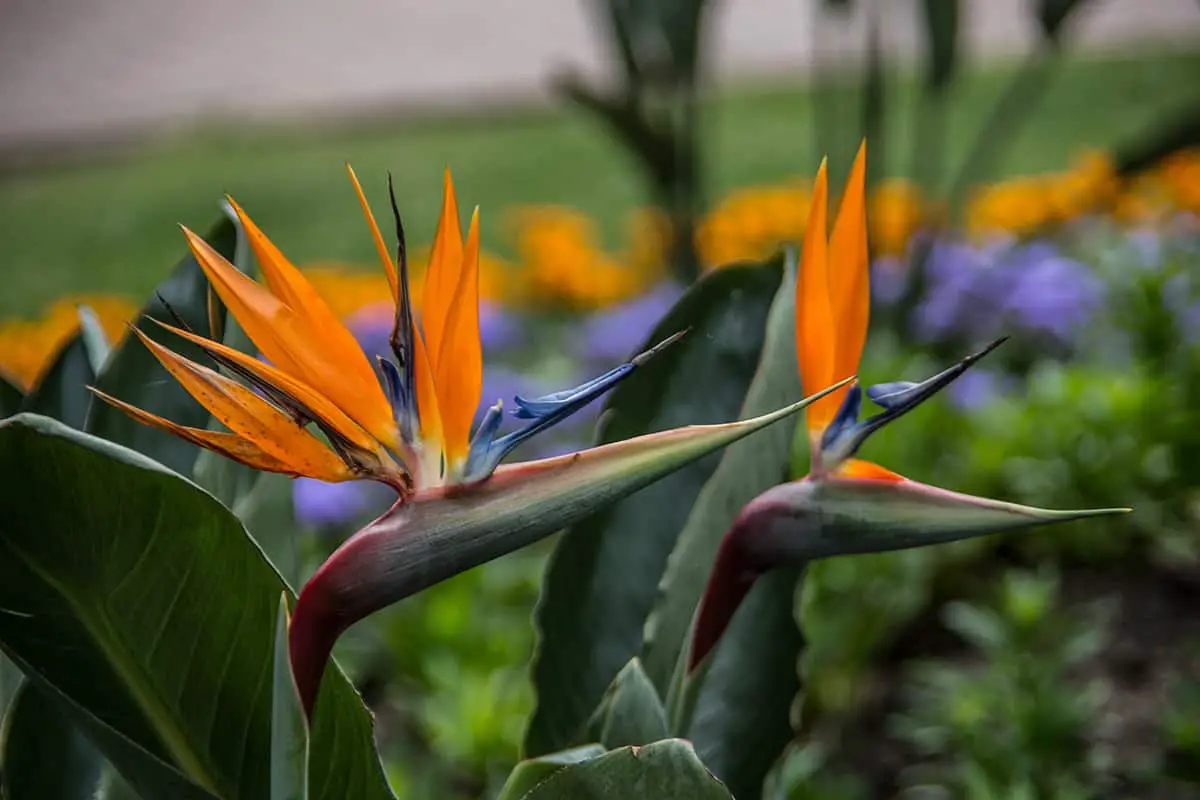
The Bird of Paradise plant makes a stunning addition to your container garden. With its vibrant and exotic flowers, it resembles a tropical bird. This plant thrives in containers and enhances your space with a touch of the tropics.
For optimal growth, place your Bird of Paradise in a location where it receives plenty of sunlight. Opt for a large container to accommodate the Bird of Paradise’s root system and support its height and spread.
Boxwood
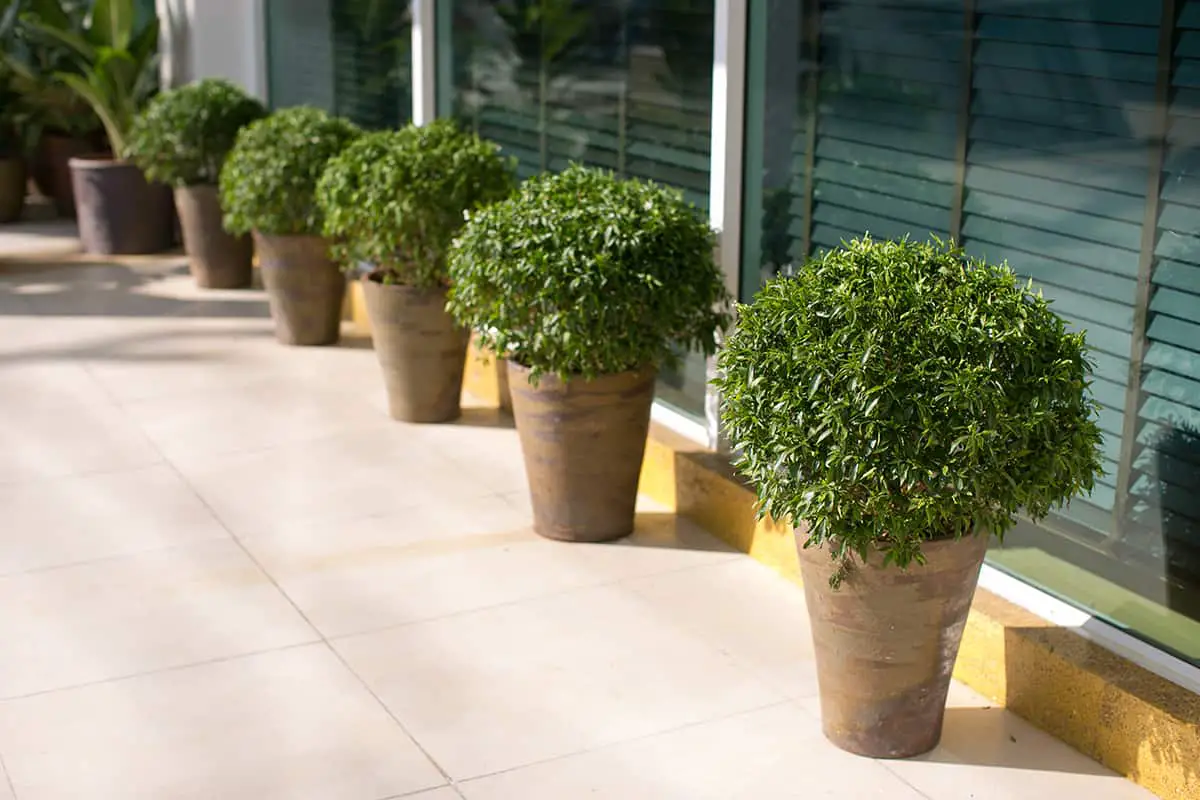
Boxwood shrubs are ideal for container gardening. They have a dense, evergreen foliage that maintains color throughout the year. In containers, they bring structure and elegance. Boxwoods are hardy and adaptable to various climates, making them a versatile choice.
Choose a suitable variety for your region. Some popular options include ‘American Boxwood’ and ‘Japanese Boxwood’. It’s important to use a well-draining soil mix to prevent root rot. Water your plant regularly, keeping the soil evenly moist but not soggy.
Provide your boxwood with adequate sunlight. A spot that receives partial to full sun is optimal. For healthy growth, apply a balanced fertilizer during the growing season. Pruning is beneficial for maintaining shape and encouraging bushier growth.
Canna Lily
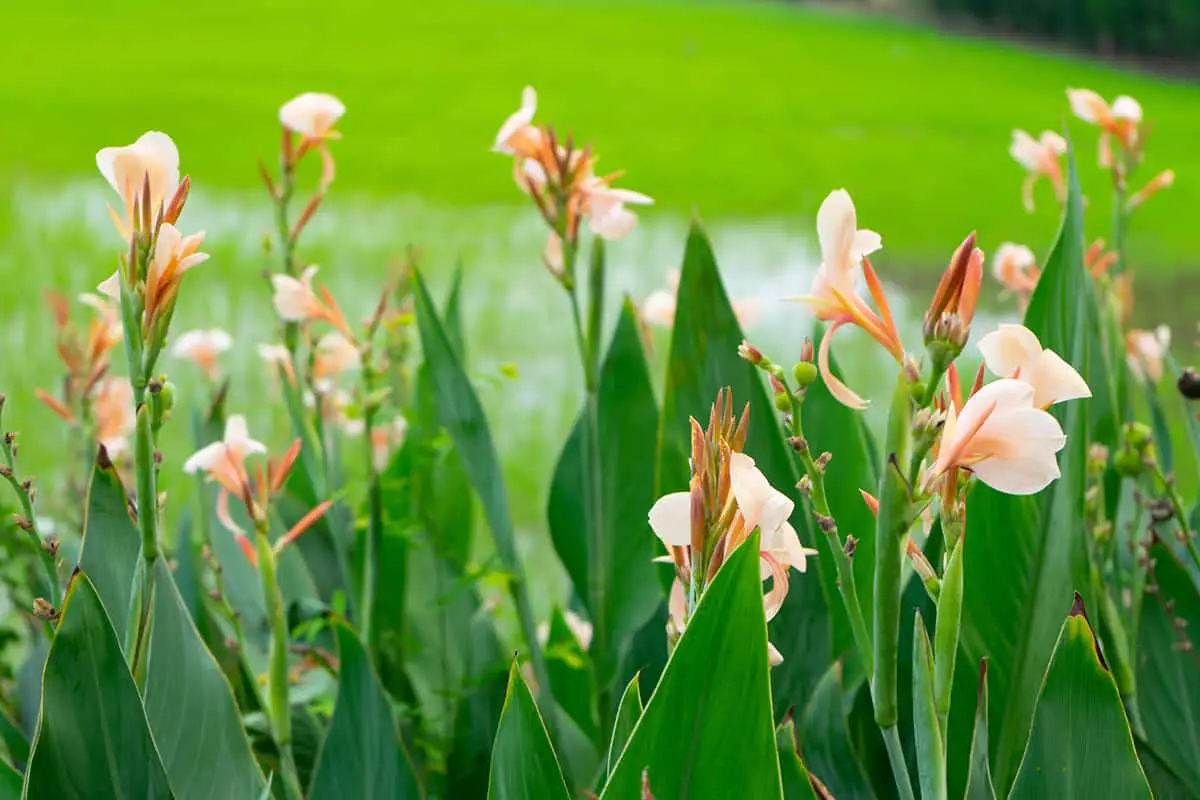
Canna Lilies are renowned for their vibrant foliage and striking flowers, making them an excellent choice for container gardening. Their lush appearance enhances patios and balconies, turning them into colorful retreats. To successfully plant and care for Canna Lilies in containers, consider the following guidance.
When choosing the container, select a large pot that is at least 18 inches in diameter to accommodate the plant’s root system, and make sure it has drainage holes to prevent waterlogging.
For planting, use a rich, well-draining soil mix. Place the rhizomes about 2 inches below the soil surface to ensure they have enough room to establish and grow.
Caring for Canna Lilies in containers involves several key practices. They thrive in full sunlight, requiring at least 6 hours of direct sun per day. It’s important to keep the soil consistently moist; water the plant when the top inch of soil feels dry to the touch. Additionally, applying a balanced fertilizer monthly during the growing season will support their vigorous growth and bloom production.
Cast Iron Plant
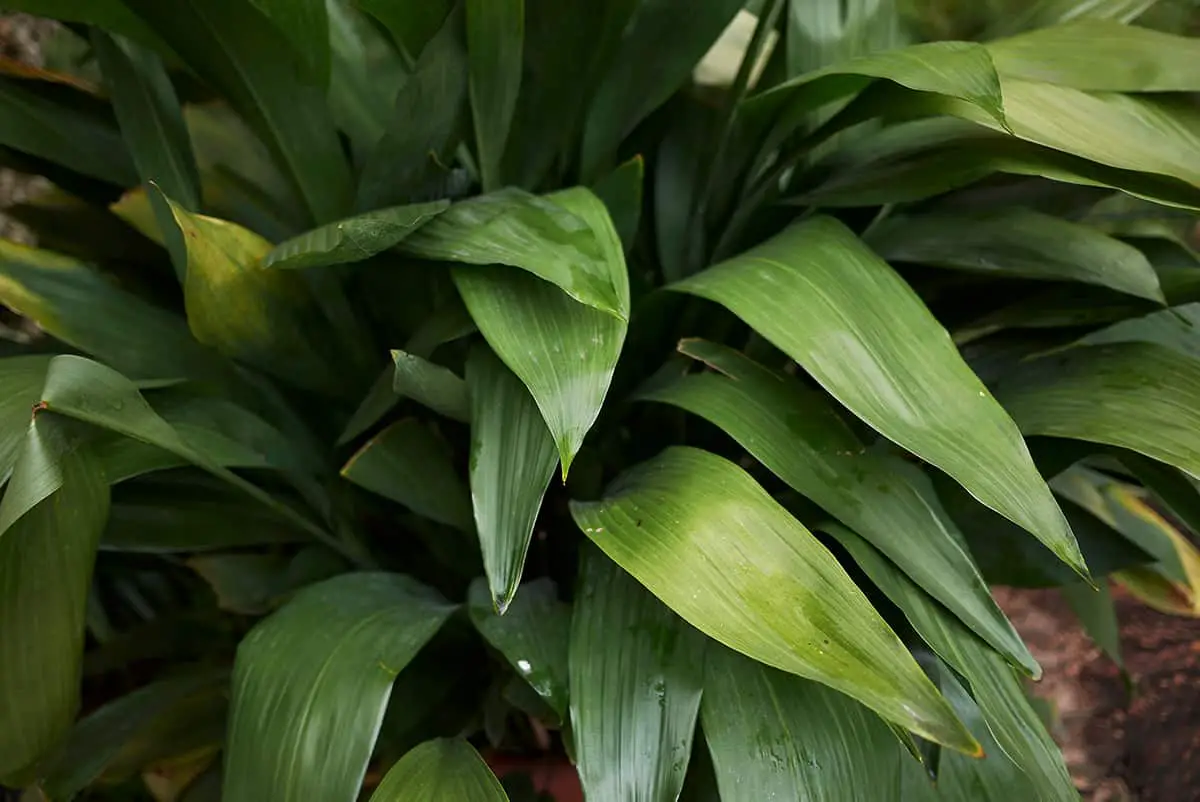
The Cast Iron Plant thrives in containers, offering a robust option for your home gardening. You’ll appreciate its ability to withstand neglect and low-light conditions. It’s suited for those new to plant care or with busy lifestyles.
This plant features long, dark green leaves sprouting from its base. It’s a slow grower, which makes it ideal for pots. Indoor care is minimal. Ensure the soil dries a few inches down before watering. Never overwater, as this can lead to root rot.
For best results, use well-drained potting mix and place your plant in low-light spots. A north-facing window is typically ideal. Infrequent fertilizing keeps it healthy—once in spring should suffice. Cast iron plants are resilient to common pests, further reducing your maintenance tasks.
This plant is not only durable but also purifies the air. It removes toxins, contributing to a healthier environment indoors. When choosing a container, opt for one with drainage holes to prevent excess water buildup.
Colocasia
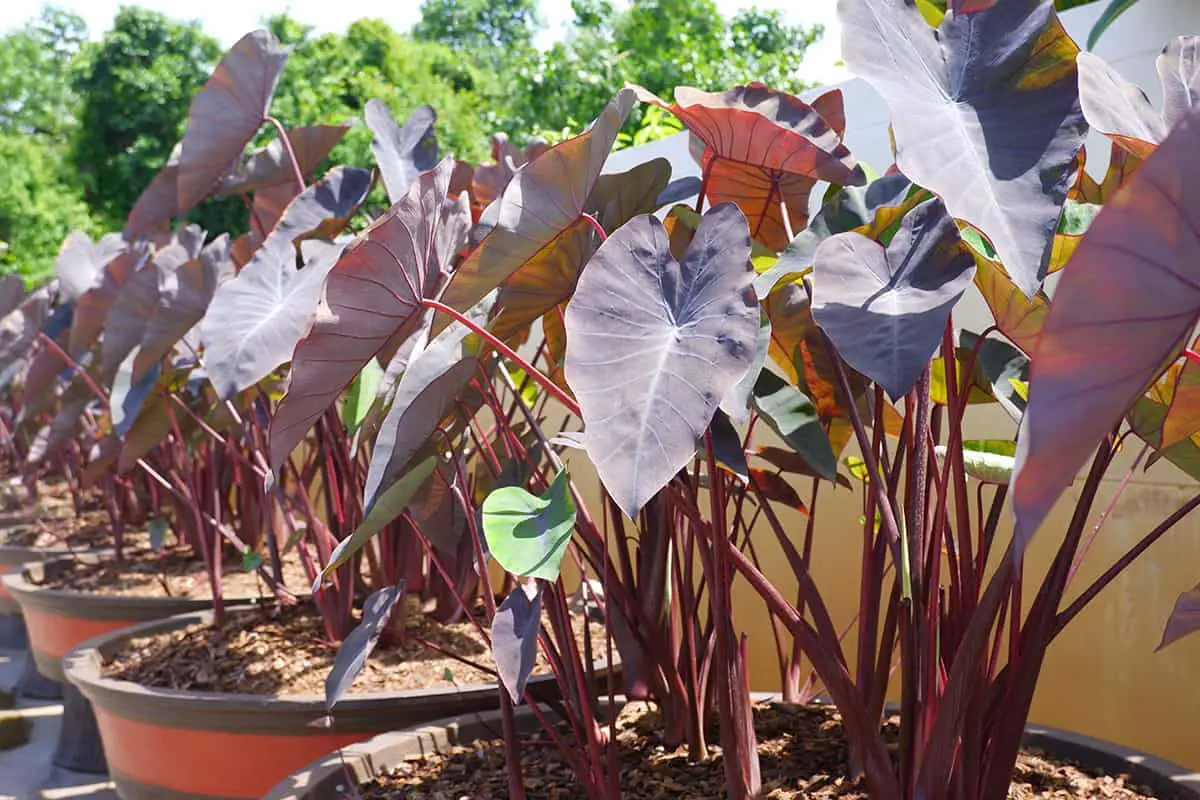
Colocasia, known for its bold foliage, thrives in containers. This plant adds a tropical accent to your patio or balcony. Opt for a large pot to accommodate its growth. It’s important to choose a container with good drainage.
Colocasia requires moist, rich soil. You can create an ideal mix using peat and regular potting soil. During summer, these plants need consistent watering. They also benefit from frequent fertilizer applications.
In terms of light, Colocasia prefers partial shade. However, varieties with darker leaves perform better in full sun. Remember to protect them from harsh afternoon light to prevent leaf burn.
Over winter, move Colocasia indoors if you live in a cooler climate. They can resume outdoor growth when temperatures rise. Ensure the indoor space has ample light and keep the soil slightly moist.
Cordyline
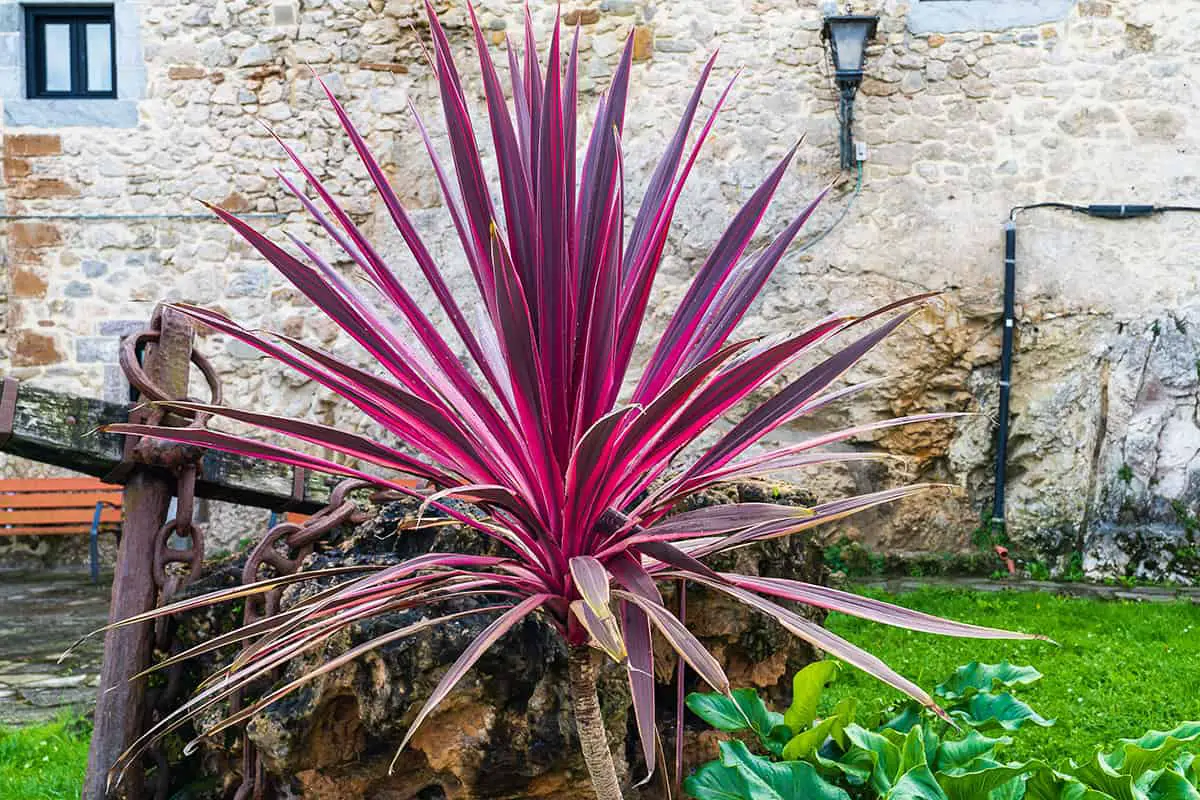
Cordyline plants are standout choices for containers due to their striking leaf colors and architectural form. You can easily elevate your patio or indoor space with this exotic-looking plant. They come in a range of colors, from green to pink, and typically maintain a symmetrical whorl of long, linear leaves.
Cordyline indivisa exhibits a particularly impressive single trunk. Over time, this variety may grow tall, even when potted, shedding its lower leaves to reveal a smooth trunk reminiscent of a palm.
When choosing a Cordyline for your container garden, consider the light requirements. These plants prefer full sun and well-drained soil. With the right conditions, the Cordyline australis, also known as the Cornish palm, may bloom with small, fragrant flowers.
Here are typical Cordyline varieties you might find:
- Cordyline ‘Cha Cha’: Begins with apricot and peach hues, turning to yellow and green.
- Cordyline indivisa: Known for a large trunk; impressive in a large container.
- Cordyline ‘Jurred’ (Festival Grass™): Features vivid burgundy-red leaves.
Remember, Cordylines need regular watering to thrive, but too much moisture can harm them. Monitor soil moisture and adjust your watering schedule as needed. With proper care, your Cordyline will grow into a visually striking feature in your space.
Dracaena
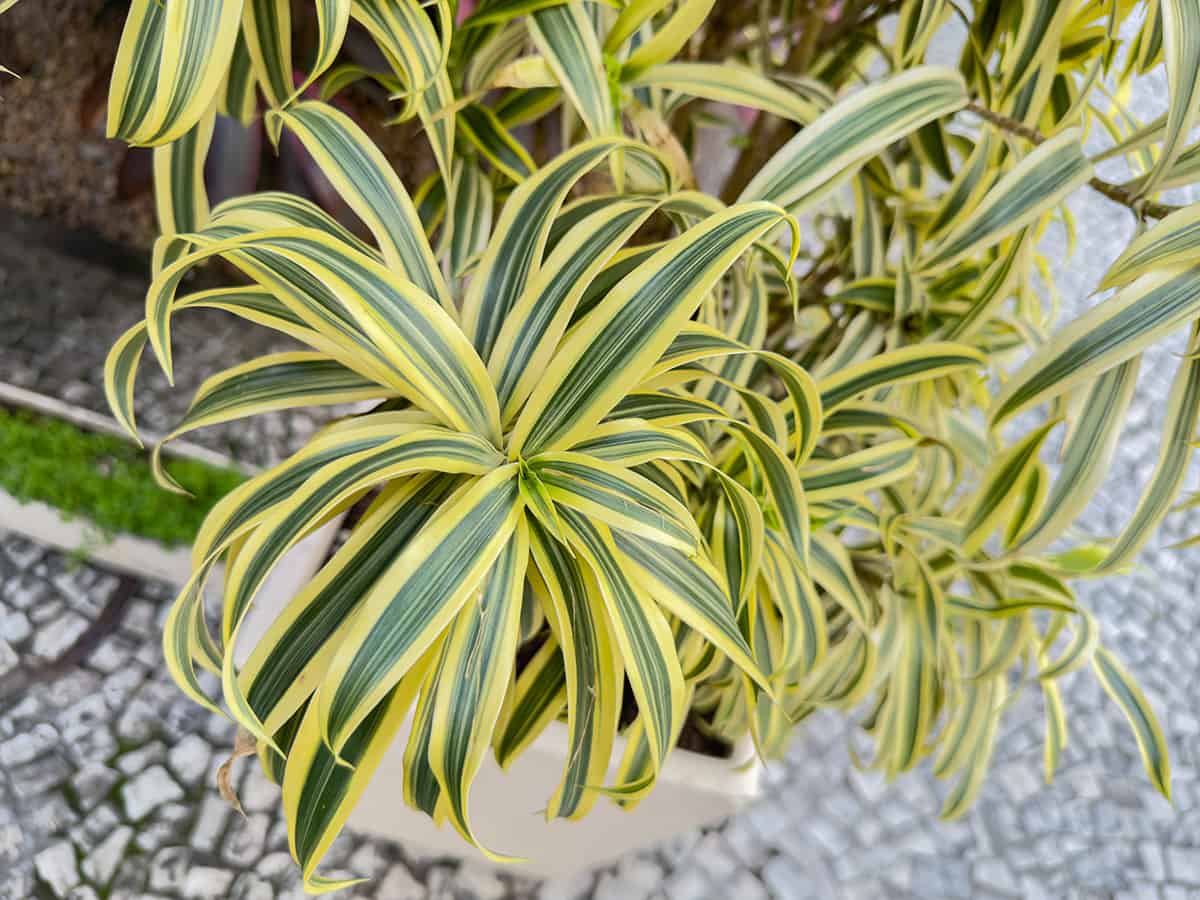
Dracaena species, characterized by their elongated leaves and architectural form, add a touch of elegance to any space. When grown in containers, they adapt well and remain at a manageable size, making them a versatile choice for interior decoration.
In terms of light and watering requirements, Dracaenas thrive in bright, indirect light. They should be watered when the soil feels dry to the touch. Their ability to forgive occasional neglect makes them particularly suitable for individuals with busy lifestyles or those who are occasionally forgetful about watering.
Among the common varieties, Dracaena reflexa var. angustifolia, often referred to as the Dragon Tree, is a notable slow-grower that withstands drought conditions well. Dracaena fragrans, known as the corn plant, complements interiors beautifully with minimalistic themes. Dracaena trifasciata, commonly known as the Snake Plant, is distinguished by its air purification abilities.
Growth and pruning are important aspects of caring for Dracaenas. These plants can grow to heights ranging from 2 to 10 feet, depending on the variety. Pruning allows for the shaping of the plant and control over its height, ensuring it fits well within your space.
It’s important to note the safety aspect of Dracaena plants; they can be toxic if ingested. Therefore, it’s advisable to keep them away from pets and children to prevent any accidental ingestion.
Dwarf Citrus Trees
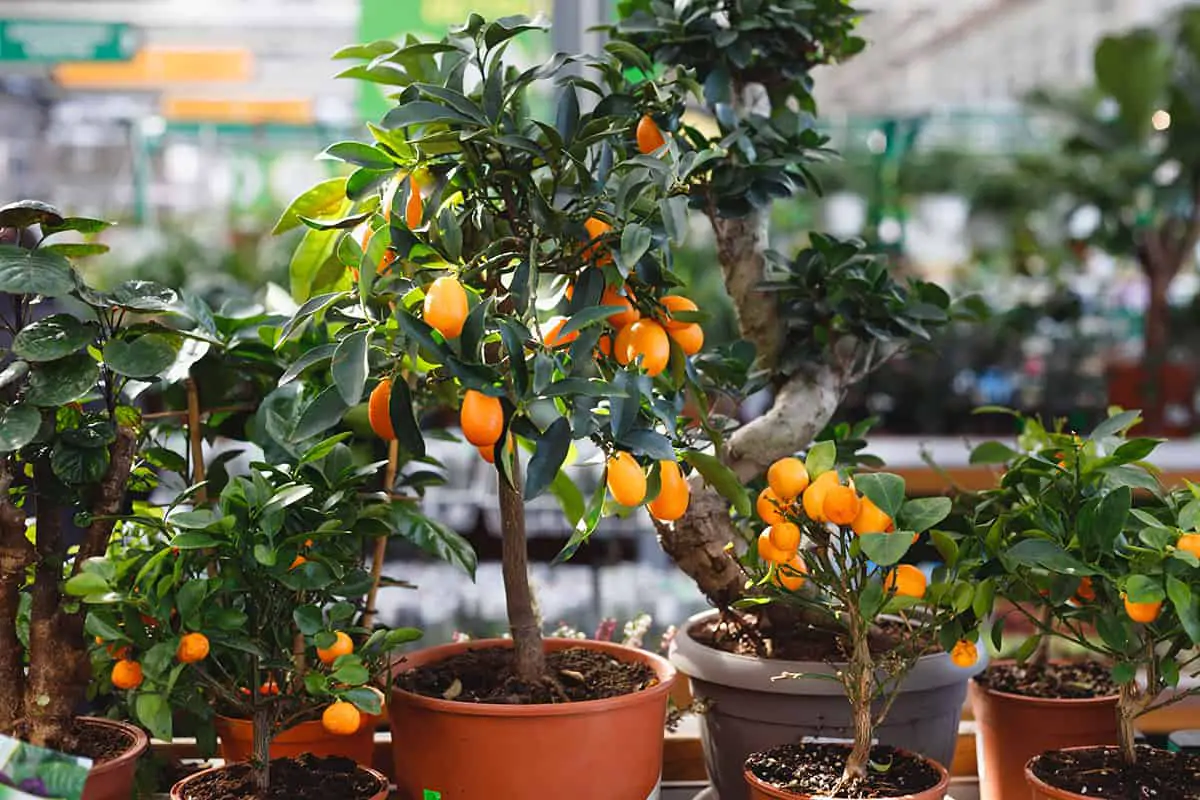
Dwarf citrus trees bring a lively touch to your space with their vibrant foliage and fragrant blooms. These compact trees are perfectly suited for container growing, making them a great addition to balconies, patios, or indoor areas where space is limited compared to standard-sized trees.
When it comes to ideal varieties for container growing, consider the Meyer lemon, dwarf orange, limequat, and calamondin.
For care tips, these trees require bright, direct light and well-draining soil. It’s important to keep the soil evenly moist, ensuring the trees are neither waterlogged nor too dry. Temperature-wise, they thrive in daytime temperatures of 65–70°F and prefer cooler nights between 55–60°F.
Pruning is essential to maintain the tree’s shape and to improve air circulation around the foliage. This contributes to the tree’s aesthetic appeal and overall health.
When potting or repotting, selecting a container with adequate drainage is crucial to prevent water accumulation at the roots. It’s advisable to repot the trees every few years to refresh the soil and support their growth.
Feeding the trees with a fertilizer specifically formulated for citrus plants will provide them with the necessary nutrients to flourish and produce fruit.
Dwarf Olive Trees
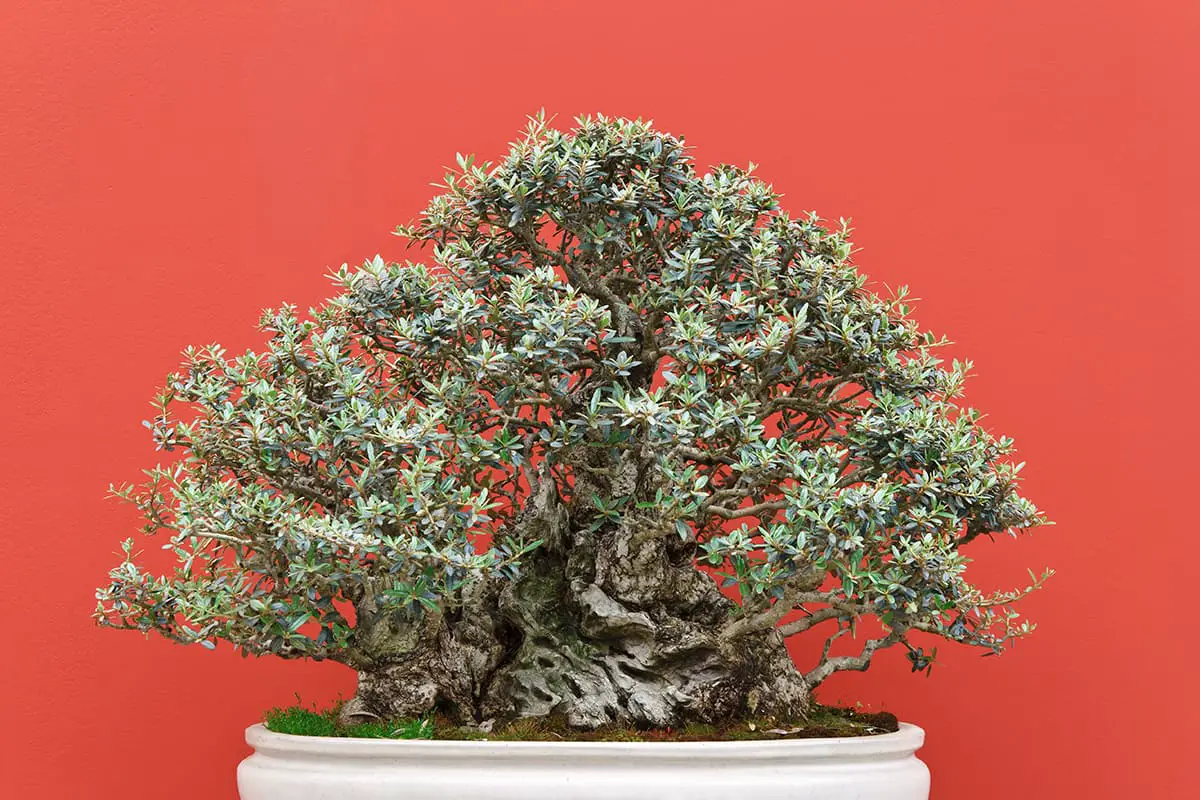
Dwarf olive trees are an excellent choice for container gardening. Their compact size allows you to enjoy the beauty of olive trees even in limited spaces. These trees require containers with adequate room for their roots to grow. As they mature, you might need to transplant them into larger pots.
Place your dwarf olive tree in an area that benefits from full sun, which entails at least six hours of direct sunlight daily. A south-facing location is particularly ideal, as it maximizes light exposure, crucial for the tree’s health and productivity.
For watering, it’s essential to regularly hydrate your tree to maintain soil moisture levels that are moist but not soggy. The container should have drainage holes to prevent water accumulation. To avoid harm to the tree, let the top inch of soil dry out before watering again, as overwatering can be detrimental.
Pruning your dwarf olive tree is necessary to keep it in shape and encourage healthy growth. Regularly remove any branches that are dead or show signs of disease. Effective pruning also assists in managing the tree’s size, making it easier to handle and more aesthetically pleasing.
Regarding temperature and hardiness, dwarf olive trees have a degree of tolerance to lower temperatures but should be protected from hard freezes. To safeguard them during extremely cold weather, consider bringing them indoors or insulating the pot to minimize exposure to harsh conditions.
Dwarf Pomegranate Tree
Dwarf pomegranate trees are compact in size, making them an ideal choice for small spaces and container gardens. These miniatures are celebrated for their vibrant orange-red flowers and dense foliage, offering an attractive addition to any setting. Despite their smaller stature, they still produce fruit, albeit smaller in size compared to regular pomegranates.
When it comes to care requirements, these trees thrive in full sun to partial shade conditions. They benefit from regular watering, with a focus on allowing the soil to dry out between watering sessions to avoid over-saturation. The soil should be well-draining and fertile to support healthy growth.
For planting, it’s recommended to choose a spacious pot that includes drainage holes to prevent water from accumulating at the roots. A soil mix specifically designed for fruit-bearing plants can provide the necessary nutrients for the dwarf pomegranate tree. Ensure that you position your tree in a location where it can receive at least 6 hours of sunlight daily to promote optimal growth and fruit production.
Pruning is important for your dwarf pomegranate tree. This will shape the tree and encourage healthier growth. Each year, trim to maintain structure and remove any dead branches.
Elephant’s Ear
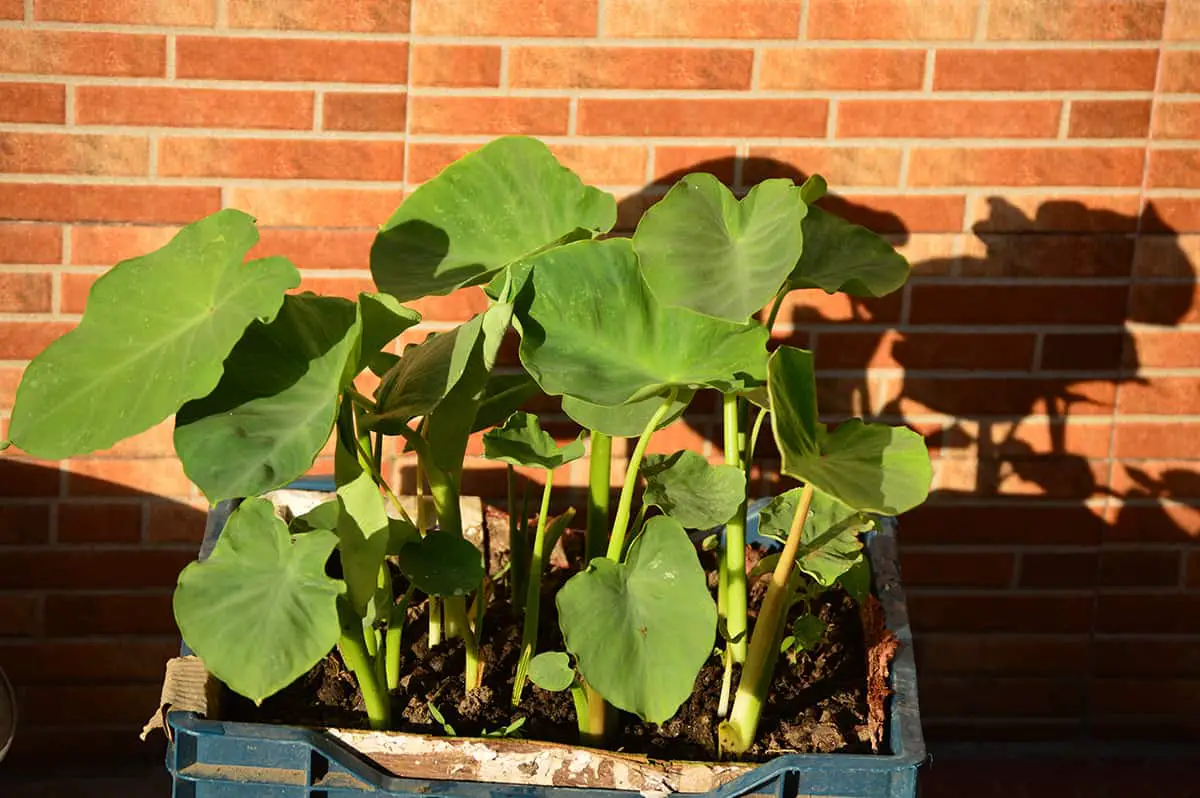
Elephant’s Ear plants add a bold, tropical effect to your container garden. Their large leaves resemble elephant ears, hence the name. They thrive in partial shade and need well-drained soil.
To plant Elephant’s Ear in containers, choose a pot that has ample room for growth. The plants perform best in warm conditions. They require regular watering and frequent fertilization to maintain vibrant foliage.
Handle Elephant’s Ear with care, as they are frost-sensitive. You should start them indoors if you live in a cooler climate. Once the risk of frost passes, move your plants outdoors. During winter, in cold areas, dig up the corms and store them to replant next season.
Euphorbia

Euphorbia, known for its diverse forms, brings structure and visual appeal to any arrangement. The Euphorbia Diamond Frost® variety, for example, is versatile enough to thrive in both containers and mixed bed settings.
This plant exhibits a growth habit that includes mounding and upright stems, reaching heights of 12-20 inches. It is celebrated for producing small, delicate white flowers that add a touch of elegance. Moreover, Euphorbia is low maintenance, making it a suitable choice for beginners in gardening.
When choosing Euphorbia for container planting, it’s important to take into account their needs for sunlight and water. Most varieties, such as Euphorbia hypericifolia, flourish in sunny locations and require moderate moisture, making their care straightforward and ensuring that your plants remain vibrant and healthy.
For optimal use, consider pairing Euphorbia with other annuals to create visual interest in your garden or container arrangement. When bringing them indoors to overwinter, it’s advisable to trim back the plants. Additionally, selecting the right container is crucial to accommodate growth and ensure proper ventilation for the plant’s health.
Fatsia Japonica
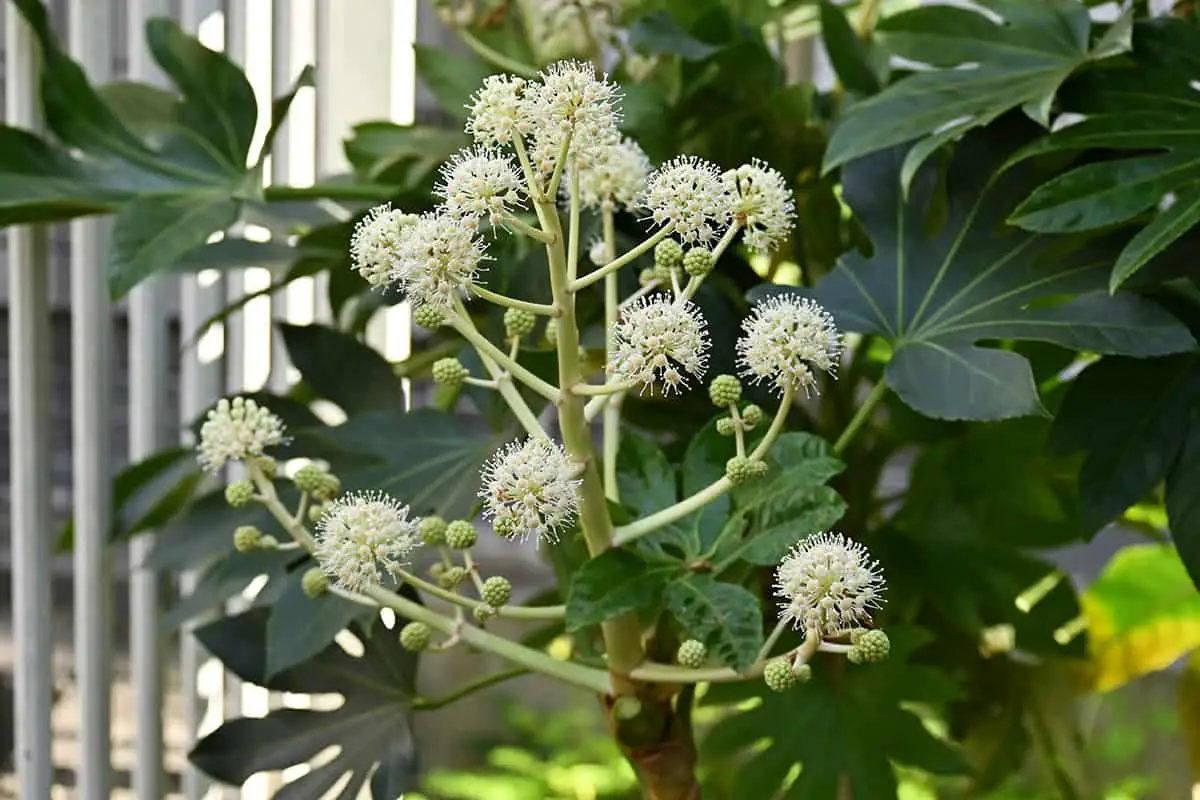
Fatsia japonica, commonly referred to as Japanese aralia, is a standout choice for container gardening due to its bold and dramatic appearance. Characterized by large, deeply-lobed leaves, it brings a touch of drama to any space.
For optimal growth, you should place your Fatsia japonica in a shady area. It performs best away from the direct glare of the sun, making a spot on a shady patio or in a protected area that shields it from wind ideal. This plant prefers environments that offer some protection from harsh conditions.
When it comes to soil, Fatsia japonica thrives in rich, well-drained conditions. While it shows a remarkable adaptability to various soil types, including clay and sandy soils, it favors acidic to neutral pH levels for its best growth.
In terms of watering and care, maintaining moist but not soggy soil is key. Fatsia japonica enjoys a humid environment and, as such, adapts well as a houseplant in indoor settings. To help sustain the desired humidity level, regularly misting the leaves is beneficial.
As for its size and growth, Fatsia japonica can reach up to eight feet in height. When cultivated in containers, regular pruning is essential to keep its size in check. Additionally, as the plant grows, its upright stems may require staking to support their development and maintain an attractive appearance.
Fiddle Leaf Fig
The Fiddle Leaf Fig (Ficus lyrata) is an ideal addition to your container garden, boasting a striking presence that commands attention. With its large, violin-shaped leaves, it seamlessly integrates into modern interior designs, significantly enhancing the aesthetic of your living space.
Regarding care instructions, the Fiddle Leaf Fig thrives in bright, indirect light. It’s best to water the plant when the top two inches of soil have dried out. When potting, this plant prefers a snug container that allows for proper drainage, ensuring its roots remain healthy.
Position your Fiddle Leaf Fig in a well-lit corner where it has the space to expand and complement open areas of your home. Selecting a container with adequate drainage is crucial to prevent issues such as root rot.
During the summer, the Fiddle Leaf Fig may benefit from being placed in a sheltered outdoor spot to enjoy the warmer climate. In contrast, it’s advisable to keep it indoors during the winter to protect it from cold damage.
To maintain a healthy plant, it’s important to avoid overfeeding. Fertilize sparingly, focusing on the growth periods of spring and summer to support its development without overwhelming it.
Giant Rhubarb
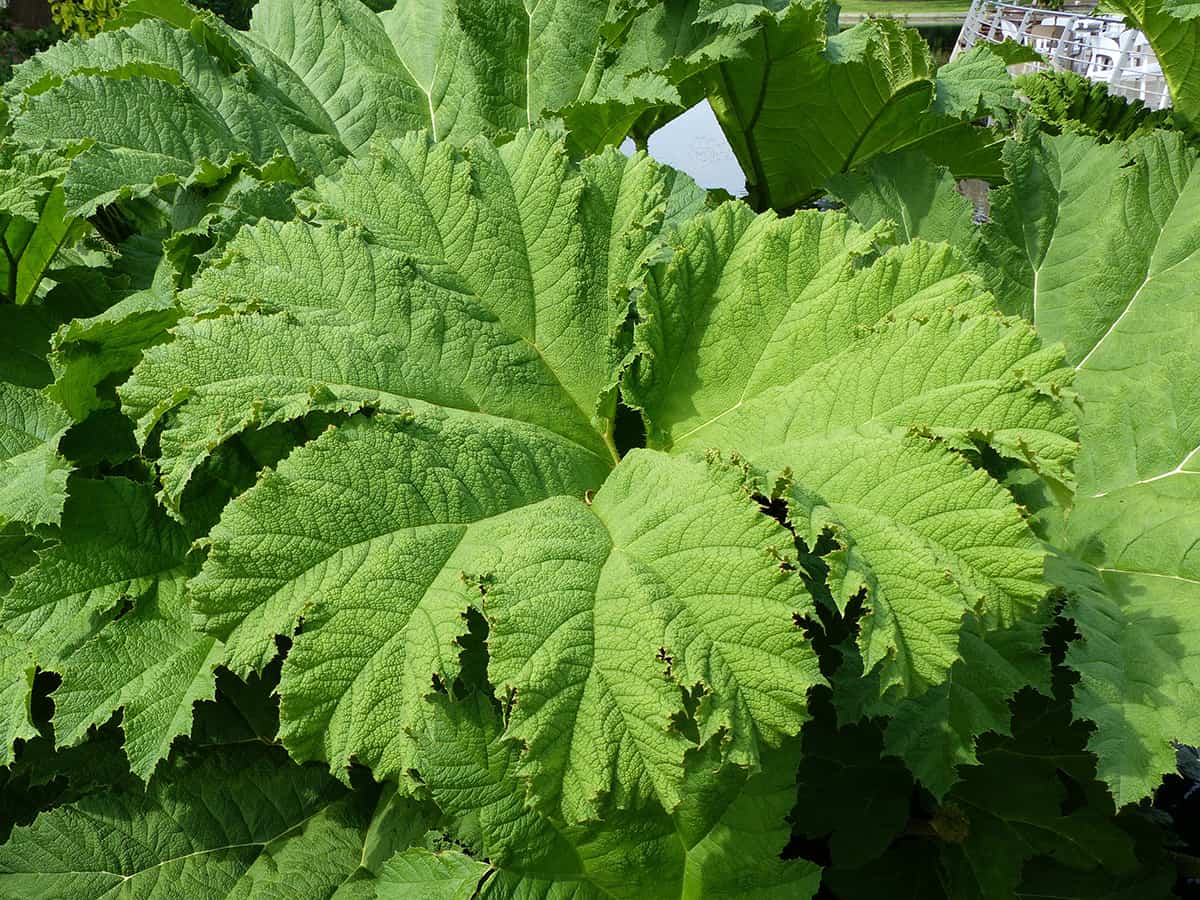
You can successfully grow Giant Rhubarb in containers and brings drama to your garden with its oversized leaves.
Giant Rhubarb thrives in moist, rich soil and partial shade. When planting, you should choose a large container. This allows the plant enough space to develop its extensive root system.
Remember to water your Giant Rhubarb regularly. Its large leaves will wilt if you let the soil dry out. During the growing season, you might need to feed it with high-nitrogen fertilizer to support its rapid growth.
You should not harvest your plant until the second year. This ensures it establishes well. Eating the leaves of Giant Rhubarb is not safe—they are toxic. However, its long stalks, when properly prepared, can be edible.
For winter, you have to protect the crowns in colder climates. You might cover them with a layer of straw or fleece.
Hens-And-Chicks
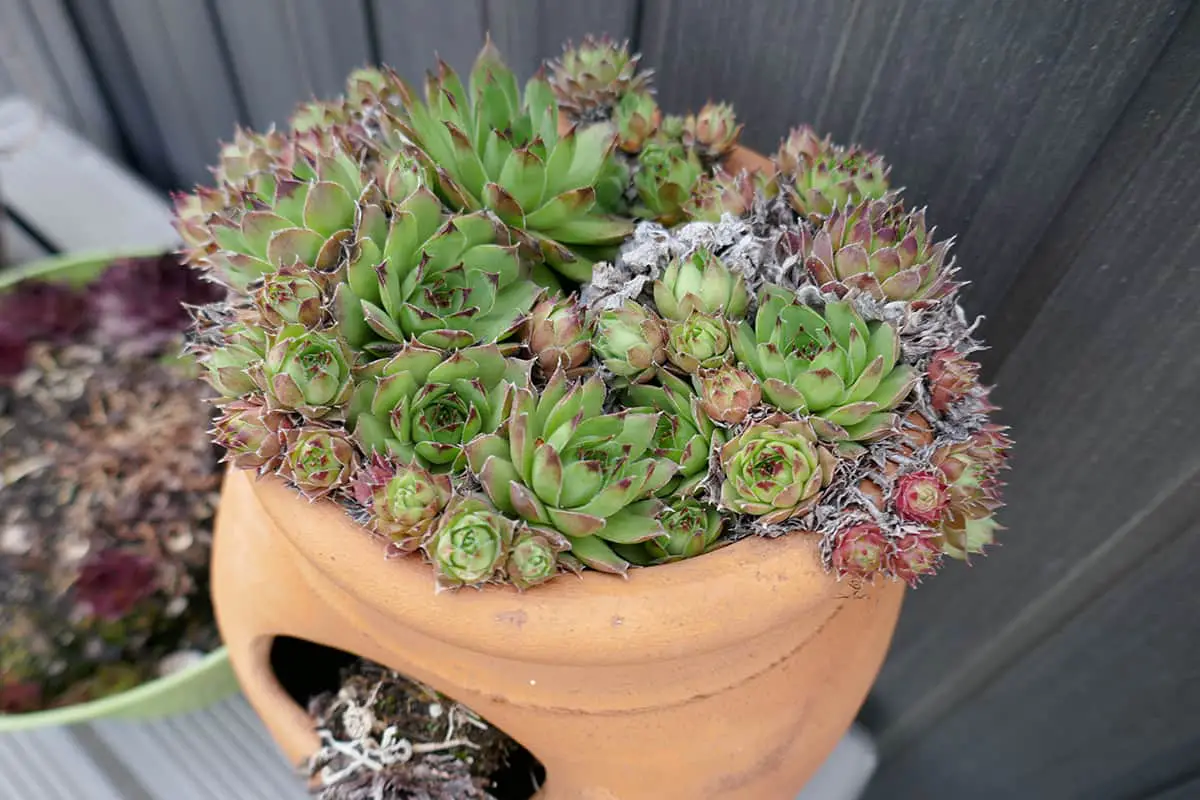
These hardy succulents provide visual interest and structure and you can easily grow them in pots.
They need well-drained soil. A mix containing sand or grit allows roots to thrive. Sempervivum tectorum prefers full to partial sun.
Propagation is simple. The ‘Chicks’ form from the ‘Hen’, the main plant. These offsets can create dense, attractive clusters.
Care involves minimal watering. Ensure the soil dries out between watering. They withstand some drought.
Hostas
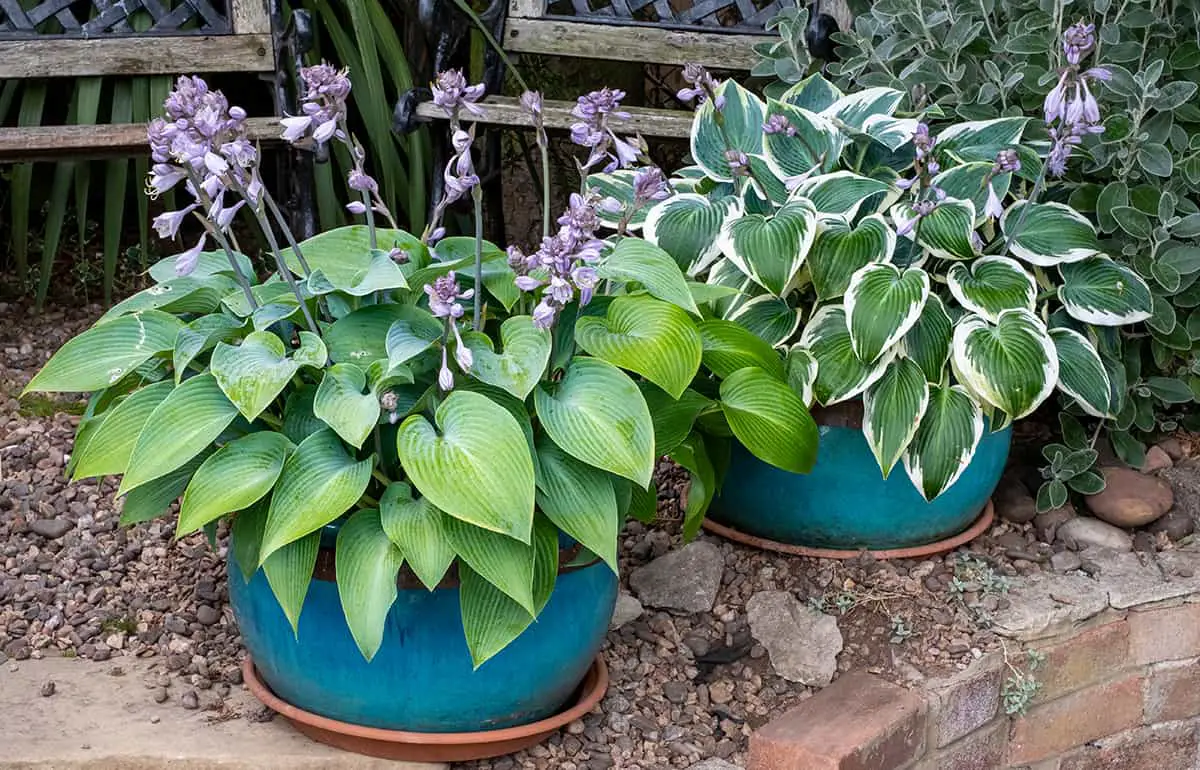
Hostas are exceptionally versatile plants that are perfect for container gardening. These leafy perennials introduce a lush aesthetic to shaded areas, making them a splendid choice for adding a sculpture-like appeal to your space.
When it comes to size and variety, hostas come in a range of sizes to suit any container and space requirement. Small types are excellent for providing low ground cover, while larger varieties can make a bold statement in your garden or living area.
Caring for hostas in containers is quite straightforward. It’s important to use well-drained, slightly acidic soil to foster their growth. Regular moisture is crucial for their optimal development, so ensure the soil is consistently moist. Applying mulch sparingly can help conserve moisture, and feeding the plants with a balanced fertilizer will support their overall health.
The placement of your hosta containers should be carefully considered to maximize their impact. Fragrant varieties are ideally positioned near walkways to enjoy their scent as you pass by. Dramatic hostas, on the other hand, can stand alone as focal points or be paired with annuals for a more dynamic display.
Jade Plant
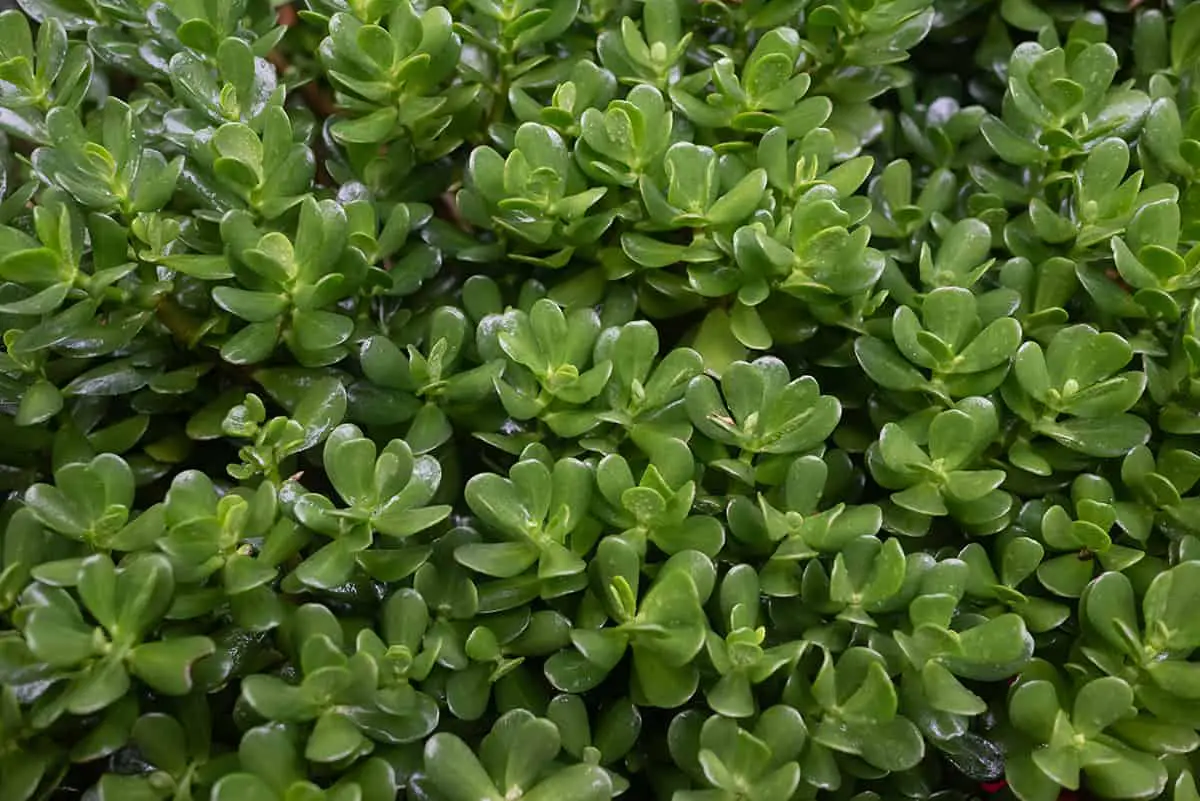
Native to South Africa, the Jade Plant thrives in well-draining soil. It’s prized for its thick, shiny, water-storing leaves, which give the plant a lush appearance. Being drought-tolerant, you don’t need to water it too frequently.
For optimal growth, provide your Jade Plant with daytime temperatures ranging from 65 to 75 °F, and cooler nights between 50 and 55 °F. It prefers bright light and some direct sun. However, too much direct sunlight can scorch the leaves, so it’s best to have some shade, especially during hot afternoons.
Pruning helps the Jade Plant stay compact and encourages vigorous growth. Spring is the best time to trim back stems to a lateral branch. Fertilize your plant 2 to 3 times in the spring and summer months using a balanced, liquid houseplant fertilizer to support its growth, but avoid over-fertilizing.
Remember, the Jade Plant can become top-heavy. Make sure its container is stable enough to support its weight as it grows.
Japanese Maple
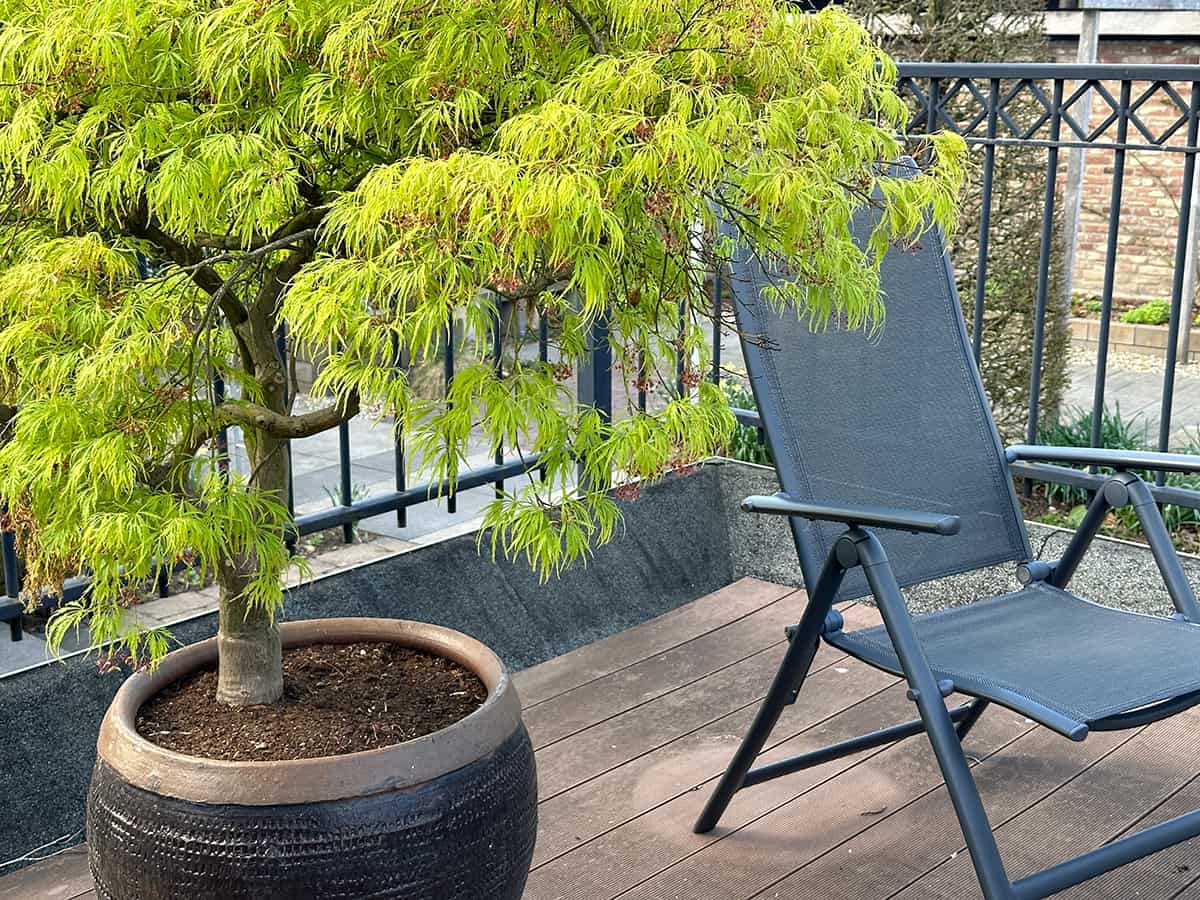
Japanese Maples are superb for growing in containers. They bring elegant structure to small garden spaces. They’re versatile in design, fitting into various garden styles.
When choosing the right variety of plants, consider slow-growing types such as ‘Mikawa yatsubusa’ for their compact growth. Select dwarf forms that are ideal for tight spaces, ensuring that they are also heat-tolerant to thrive in your specific environment.
For planting, it’s essential to use well-drained soil that ranges from acidic to neutral pH levels. Additionally, ensure that the container you select is sufficiently large to accommodate root growth, allowing your plant to develop healthily.
In terms of care and maintenance, position your Japanese Maple in an area that receives partial shade to full sun, depending on the specific needs of the variety you have chosen. Regular watering is crucial to keep the soil consistently moist but avoid waterlogging. During the growing season, applying a balanced, slow-release fertilizer will support the health and growth of your plant.
Be vigilant for potential problems such as pests, including aphids, and diseases like leaf scorch, which can adversely affect your plant. It’s also important to take measures to protect your Japanese Maple from harsh conditions, such as frost, to ensure its longevity and vitality.
Ornamental Grasses
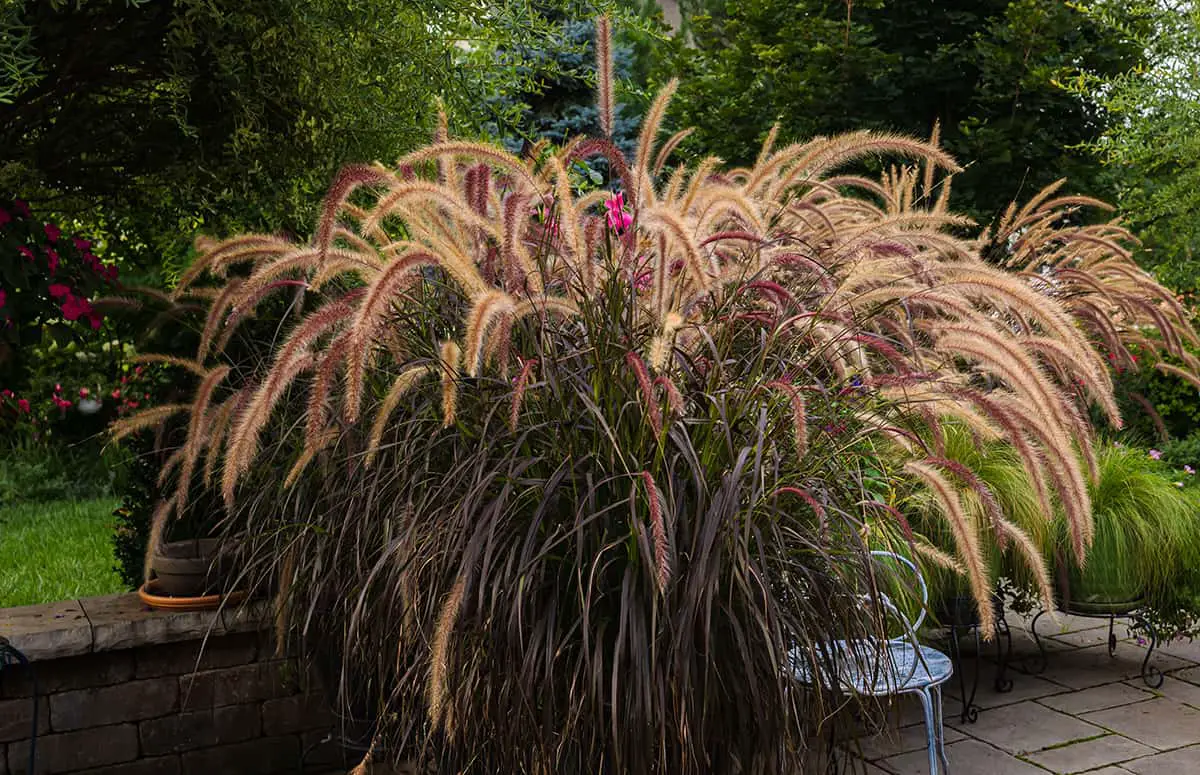
Ornamental grasses have the power to elevate the look of your container garden by adding height, texture, and a splash of color.
When choosing your grass, it’s important to select species that are compatible with the size of your container. Taller varieties will require larger pots to accommodate their growth. Additionally, make sure the grasses are suitable for your local climate, ensuring they will thrive in your specific region.
For planting, the pot must have adequate drainage holes to prevent water accumulation. Use a high-quality potting mix for optimal growth. Place the grass in the center of the container and fill the surrounding area with soil to cover the roots properly.
In terms of care and maintenance, it’s crucial to water the plants thoroughly while being mindful to avoid overwatering. Once established, ornamental grasses typically require less water. Trimming the grasses in early spring is advisable to encourage fresh, new growth.
Here are examples of ornamental grasses that can enhance your container garden:
- Pennisetum setaceum is admired for its feathery plumes that add a soft texture.
- Miscanthus sinensis stands out with its tall, graceful form, making it a striking addition.
- Carex oshimensis is ideal for those seeking lower-growing foliage, perfect for adding depth without overwhelming height.
Palm Trees
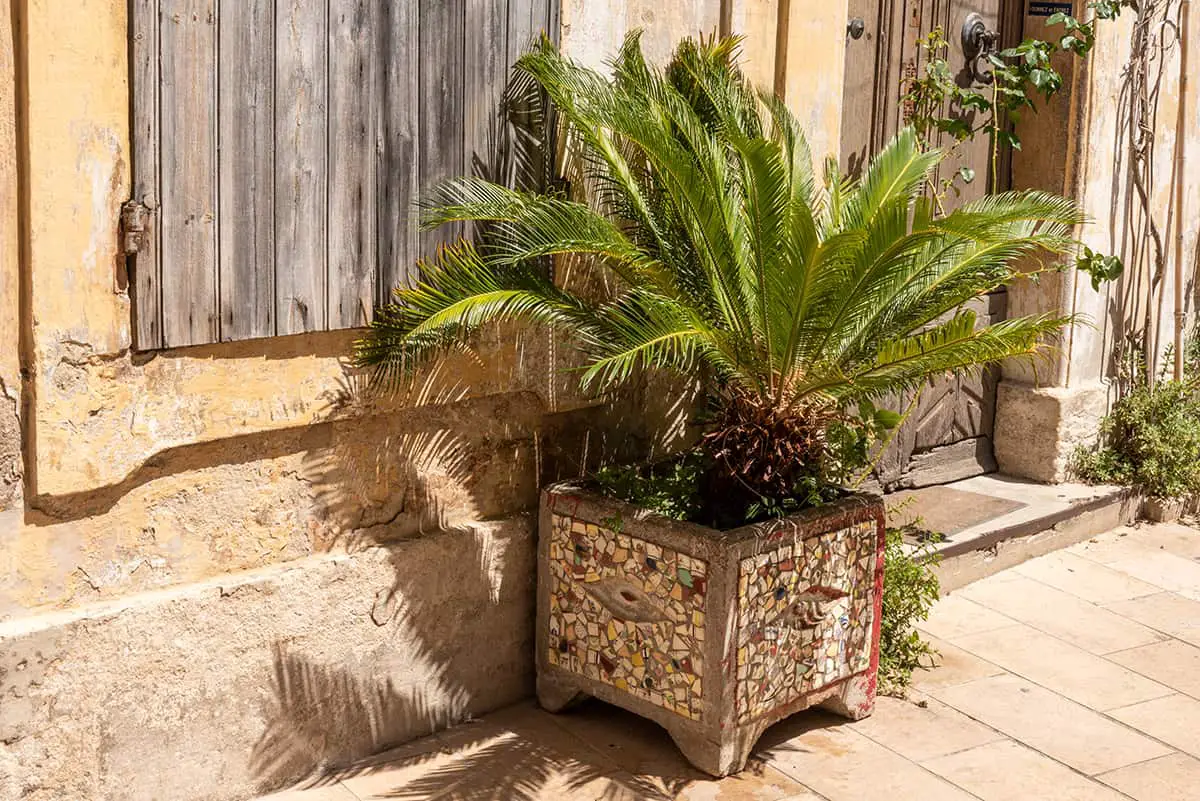
Palm trees’s adaptability makes them ideal for container gardening. You can enjoy their tropical allure on patios, decks, and in other outdoor spaces. Their adaptability makes them ideal for containers.
Select dwarf or slow-growing species. These include the European Fan Palm and the Pygmy Date Palm. They thrive in pots and add a touch of exoticism to your space.
Ensure your palm trees get plenty of sunlight. Water them when the top inch of soil feels dry. Palms prefer consistent moisture, but overwatering can harm them. Nutrition is vital as well. Use a balanced, slow-release fertilizer during their growing season.
Palms housed in containers should reside in well-lit areas. Avoid locations with harsh winds or extreme temperature changes. Some cold-hardy palms can endure chillier climates.
For a successful growth, be attentive to the roots and repot as necessary to prevent root-bound conditions.
Phormium
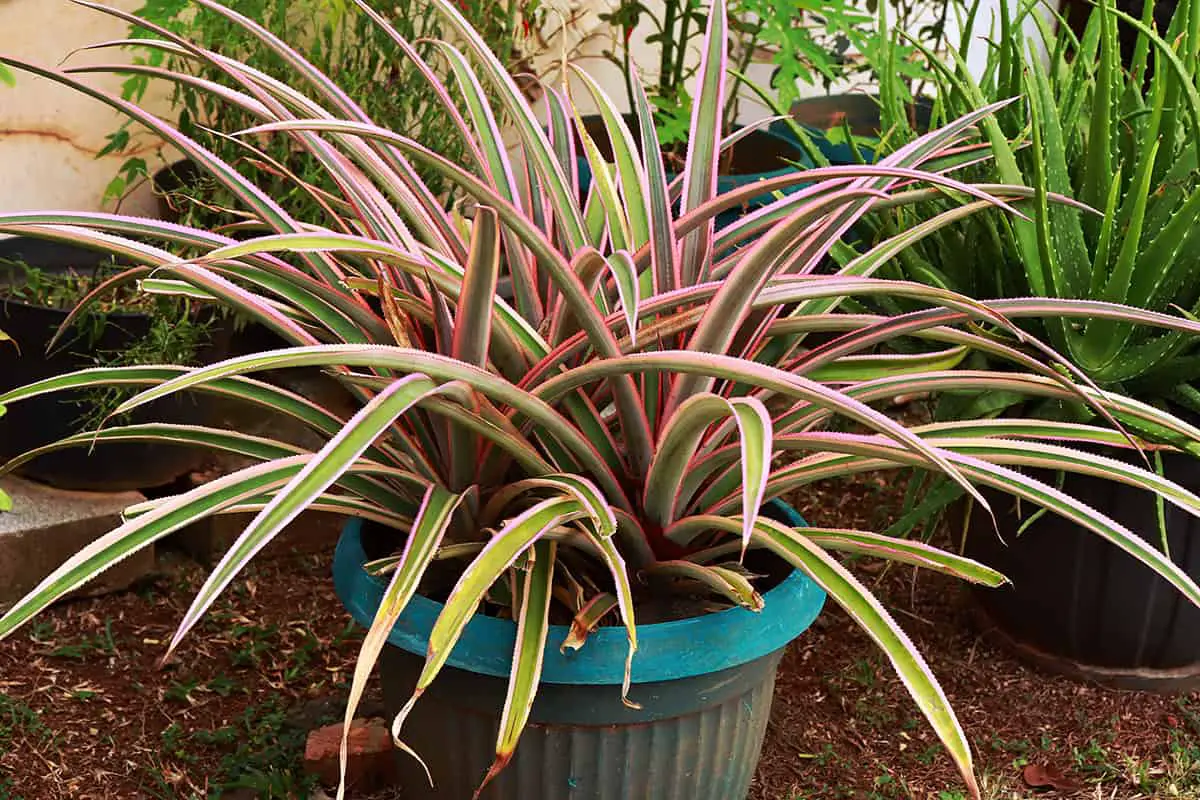
Rubber Plant
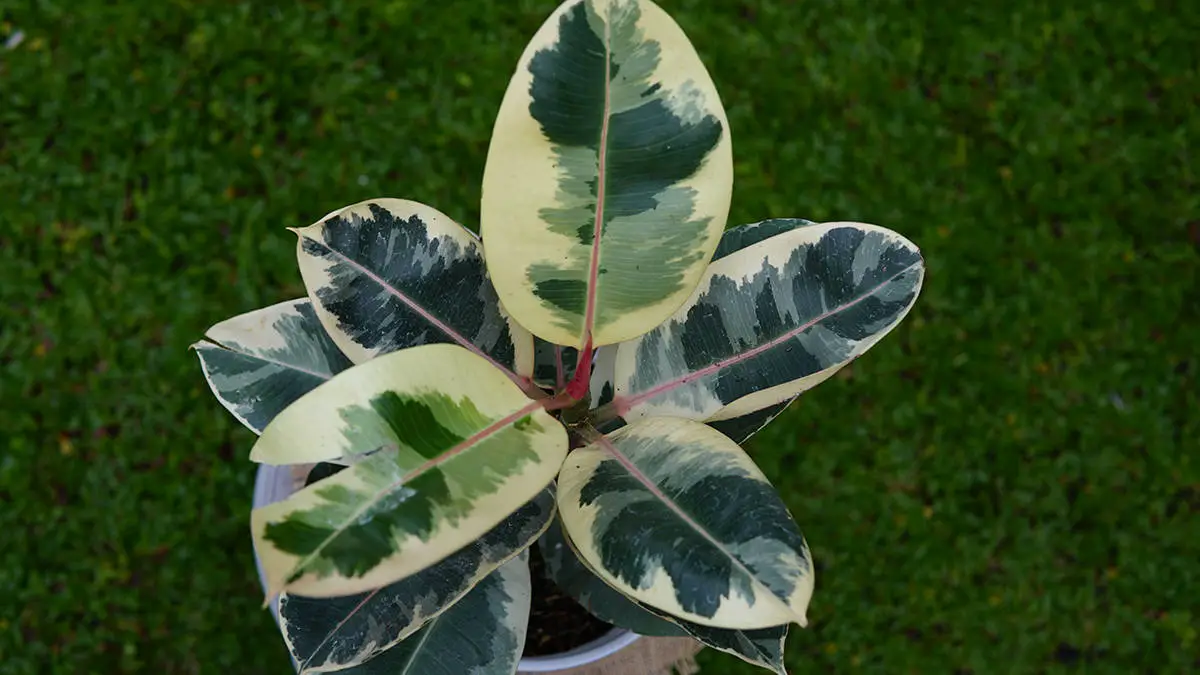
The Rubber Plant, also known as Ficus elastica, presents a distinctive option for container gardening. Its leathery leaves and strong presence add a bold aesthetic, making it perfect for infusing a tropical vibe into your living space.
In terms of light and temperature requirements, the Rubber Plant flourishes in bright light but is also adaptable to lower light conditions. Exposure to morning light is particularly beneficial. The ideal daytime temperatures for this plant range from 75 to 80°F, with nighttime temperatures preferred between 60 to 65°F. It is crucial to shield the plant from temperatures dropping below 55°F to ensure its health and growth.
Regarding watering and soil, it’s important to maintain consistently moist soil without allowing it to dry out entirely. A well-draining, soil-based potting mix is recommended for optimal growth and health of the Rubber Plant.
As for height and growth, while the Rubber Plant can grow quite tall, its height can be effectively managed indoors. Regular pruning allows you to maintain the plant at your desired size, ensuring it complements your space beautifully. Consider re-potting when the plant outgrows its container.
Sago Palm
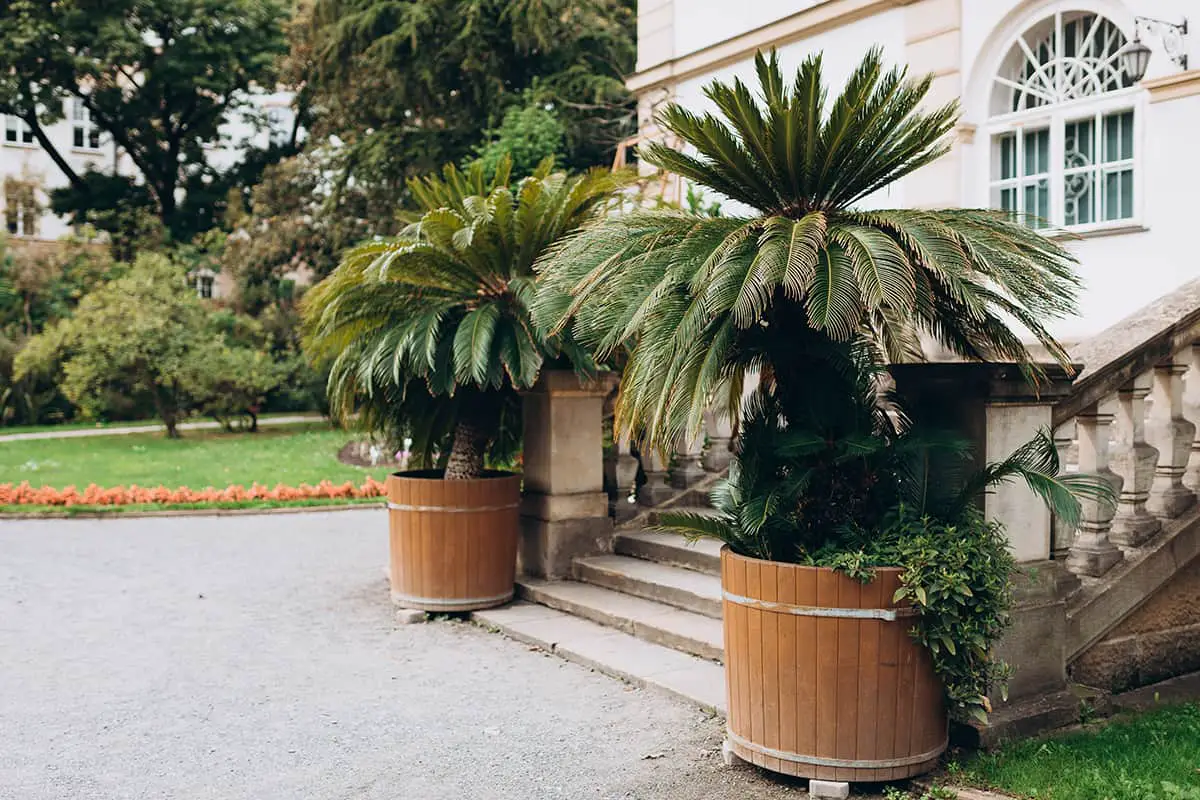
You’ll find Sago Palms well-suited for container growth in outdoor patios or even indoors. Their stiff, feather-like fronds make a bold statement wherever they are placed.
These plants are drought-tolerant but sensitive to overwatering. They can experience root rot if left in soggy soil for too long. Succinct watering practices will help your Sago Palm thrive.
Sago Palms are slow-growers, offering a long-lived addition to your collection. They’re hardy to 15 degrees Fahrenheit, although leaves may suffer in lower temperatures.
Sago Palms produce pups, which are new plants you can separate from the main plant. Whether you keep the pups for a fuller look or remove them to create new plants is up to you.
Keep in mind that Sago Palms are toxic if ingested, so they should be kept away from pets and children. This precaution is crucial for maintaining a safe home environment.
Succulents
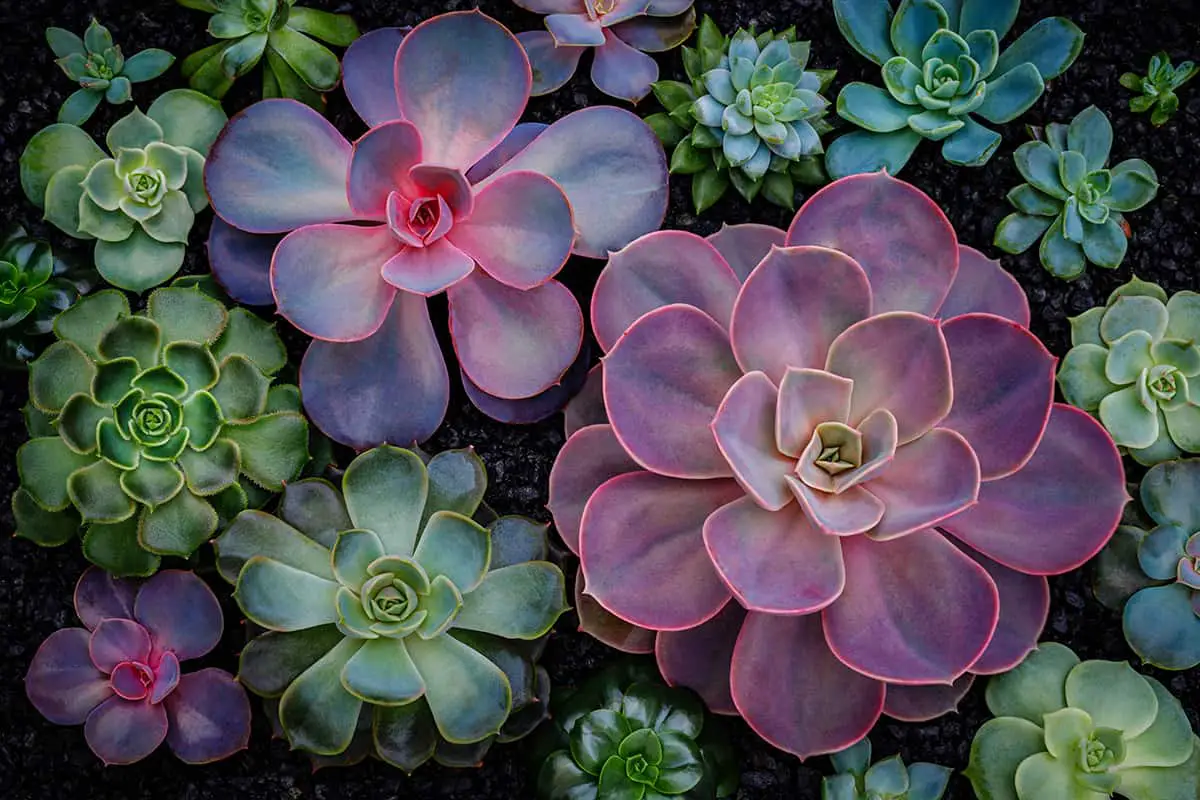
Succulents are perfectly suited for container gardening due to their hardy nature and minimal care requirements. These resilient plants are adept at storing water in their leaves, stems, or roots, allowing them to thrive in well-drained soil and bright sunlight.
When choosing a container for your succulents, opt for a pot that features a large drainage hole to prevent water accumulation. Shallow terra cotta or clay pots are ideal as they facilitate proper drainage and prevent moisture retention. It’s advisable to steer clear of deep containers that could potentially trap excess moisture, posing a risk to the plant’s health.
For planting your succulents, begin by filling the container with a well-draining soil mix. This provides a conducive environment for their growth. Next, creatively arrange succulents of varying shapes, colors, and heights to achieve an aesthetically pleasing composition. Ensure there is space between the soil surface and the top of the pot to facilitate easy watering and growth.
Care tips for maintaining your succulents include watering them sparingly, only after allowing the soil to completely dry out between waterings. During the growing season, apply fertilizer lightly to support their health and growth. Lastly, position your succulents in a location where they can bask in several hours of direct sunlight each day, ensuring they thrive and flourish.
Swiss Cheese Plant
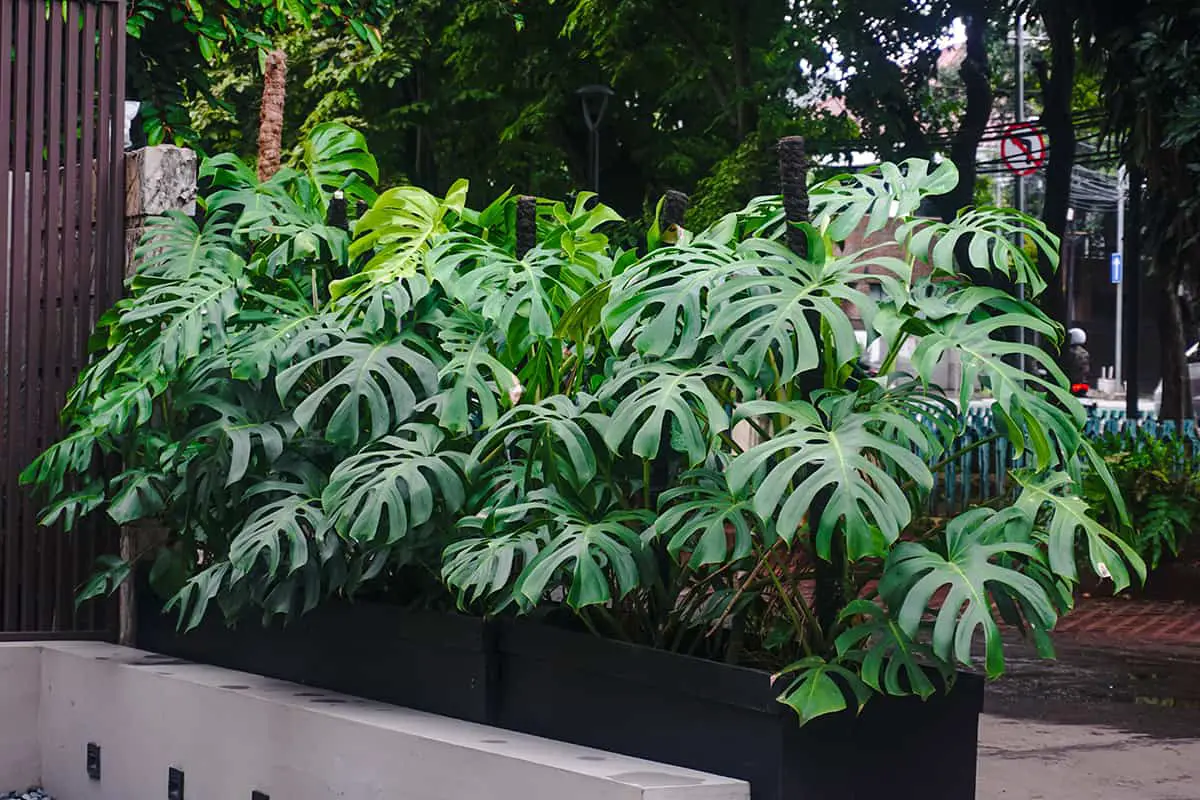
The Swiss Cheese Plant thrives in containers. With its distinctive holes, it adds a bold look to any space. Choose a large container for its rapid growth. This plant requires indirect sunlight and moist soil to flourish. For propagation, cut a stem below a leaf node. Place in water. Roots will grow. Then, plant in soil.
Yucca
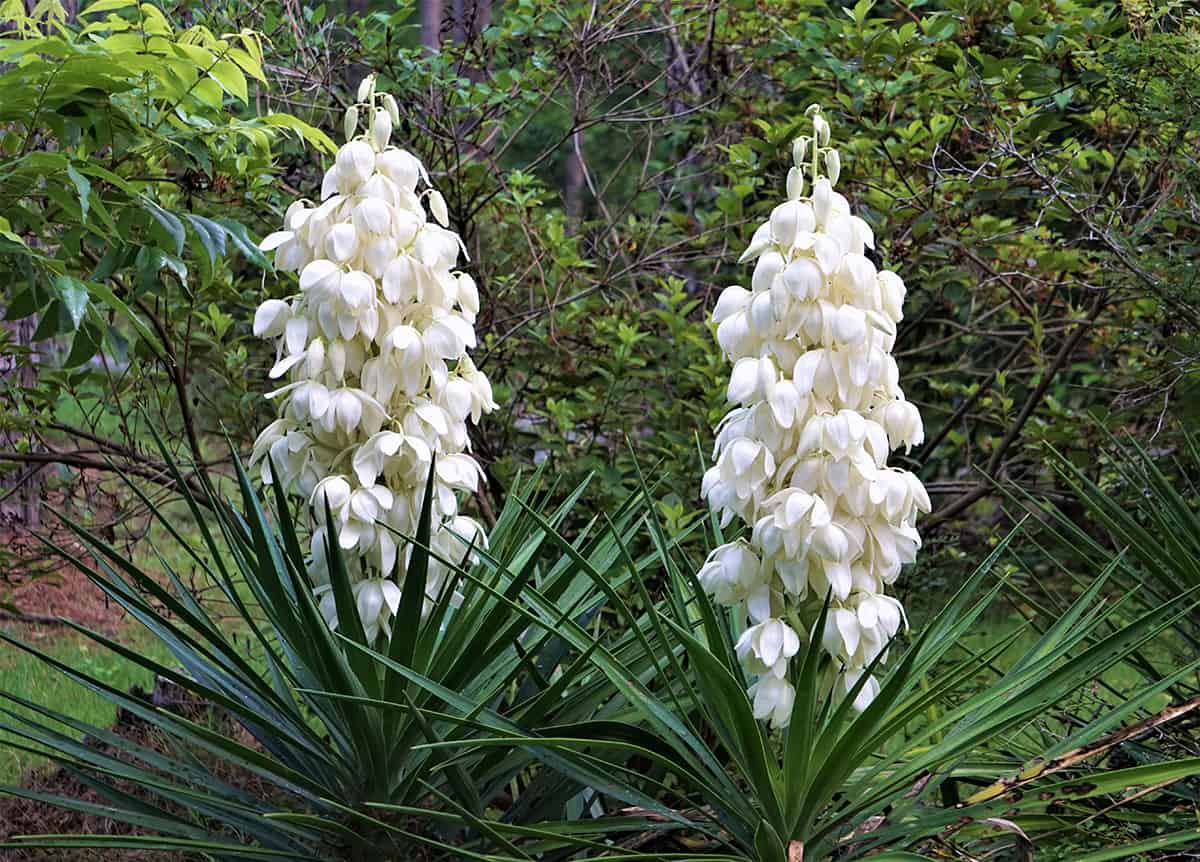
These robust perennials add an architectural flair to outdoor spaces with their sword-like foliage, creating an eye-catching visual effect. Yuccas are particularly suited for container gardening, thanks to their root system that doesn’t expand excessively.
When it comes to light requirements, yuccas flourish in full sun but can also tolerate partial shade, although their growth may be slower in less light.
For water and soil needs, it’s important to let the soil dry out between waterings. Opting for well-draining soil is crucial to avoid root rot, ensuring the yucca’s health.
Yuccas are notably heat-tolerant and certain varieties can withstand cold temperatures down to -20°F, showcasing their versatility in different climates.
If you’re considering a yucca for your container, the ‘Golden Sword’ variety, with its distinctive yellow stripe down each leaf, is an excellent choice. The ‘Color Guard’ variant, featuring a gold-centered leaf, also provides year-round interest and brightens winter landscapes.
A few key considerations for growing yuccas include selecting a container that ensures adequate drainage, avoiding overwatering to maintain the plant’s health, and fertilizing sparingly. Yuccas require minimal additional nutrients, making them a low-maintenance option for gardeners.
Yuccas flower too, sending up stalks with white, bell-shaped blossoms. These flowers often attract pollinators to your garden.
Zebra Plant
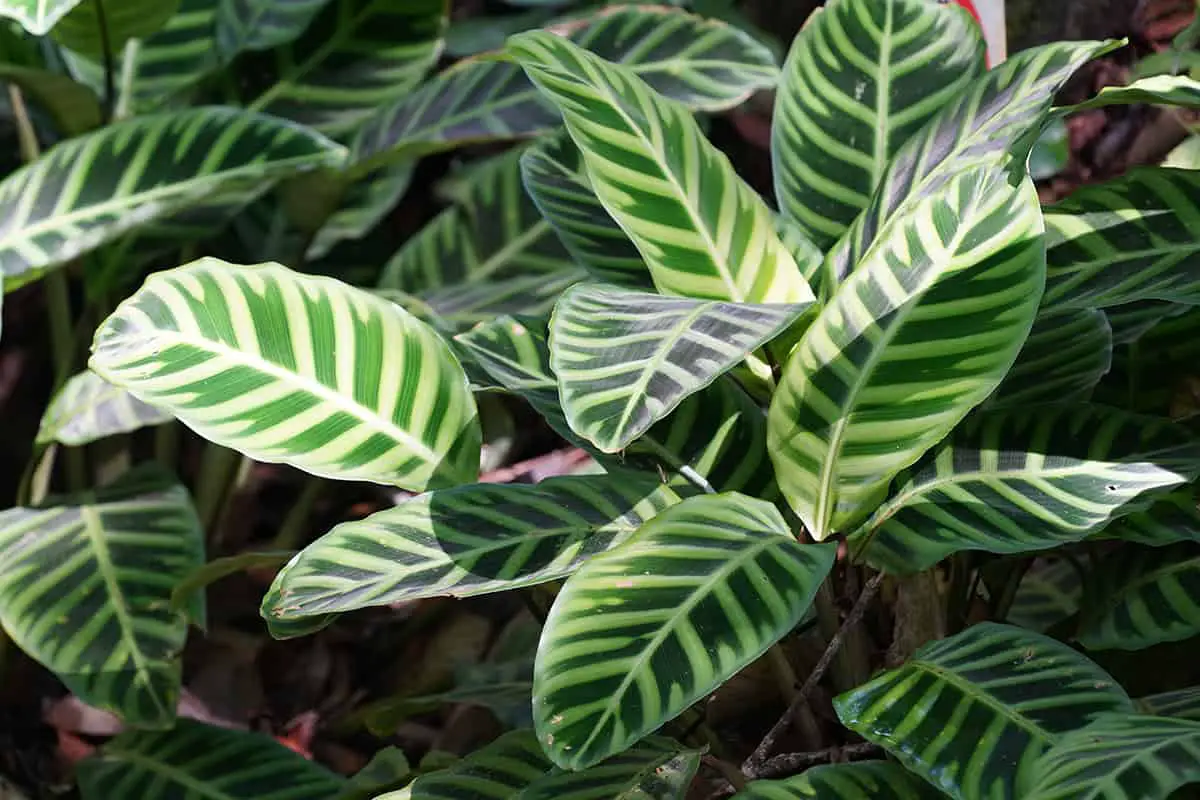
The Zebra Plant, with its distinctive architecture, brings a striking presence to your container garden thanks to its uniquely patterned leaves that offer considerable visual appeal.
For care and growth, it is crucial to provide well-drained soil for the Zebra Plant. During the growing seasons of spring and summer, nourish it with a cactus fertilizer to support its health and vigor. Annual repotting is recommended to ensure optimal growth and to refresh the soil, which can become depleted of nutrients over time.
Regarding pruning and propagation, it’s advisable to prune the Zebra Plant after it has flowered. This helps maintain its shape and encourages a more compact, aesthetically pleasing growth habit. For those looking to propagate new plants, stem cuttings can be a successful method, allowing you to expand your collection or share with friends.
To create optimal conditions for the Zebra Plant, position it in a spot where it can receive bright, indirect light. It’s also important to maintain temperatures above 65°F (18°C) to ensure the plant’s well-being, as it thrives in warm environments.
